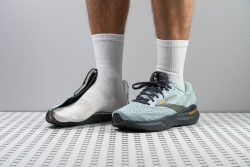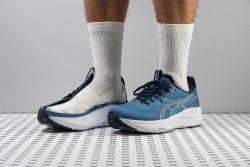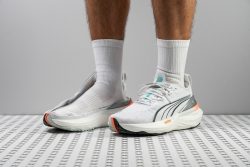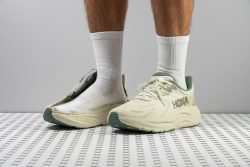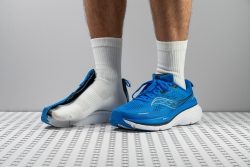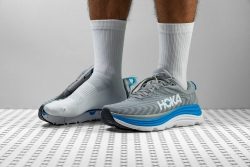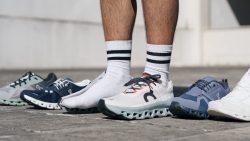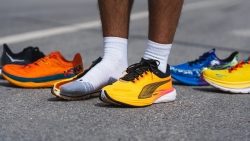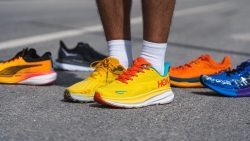7 Best Stability Running Shoes in 2025
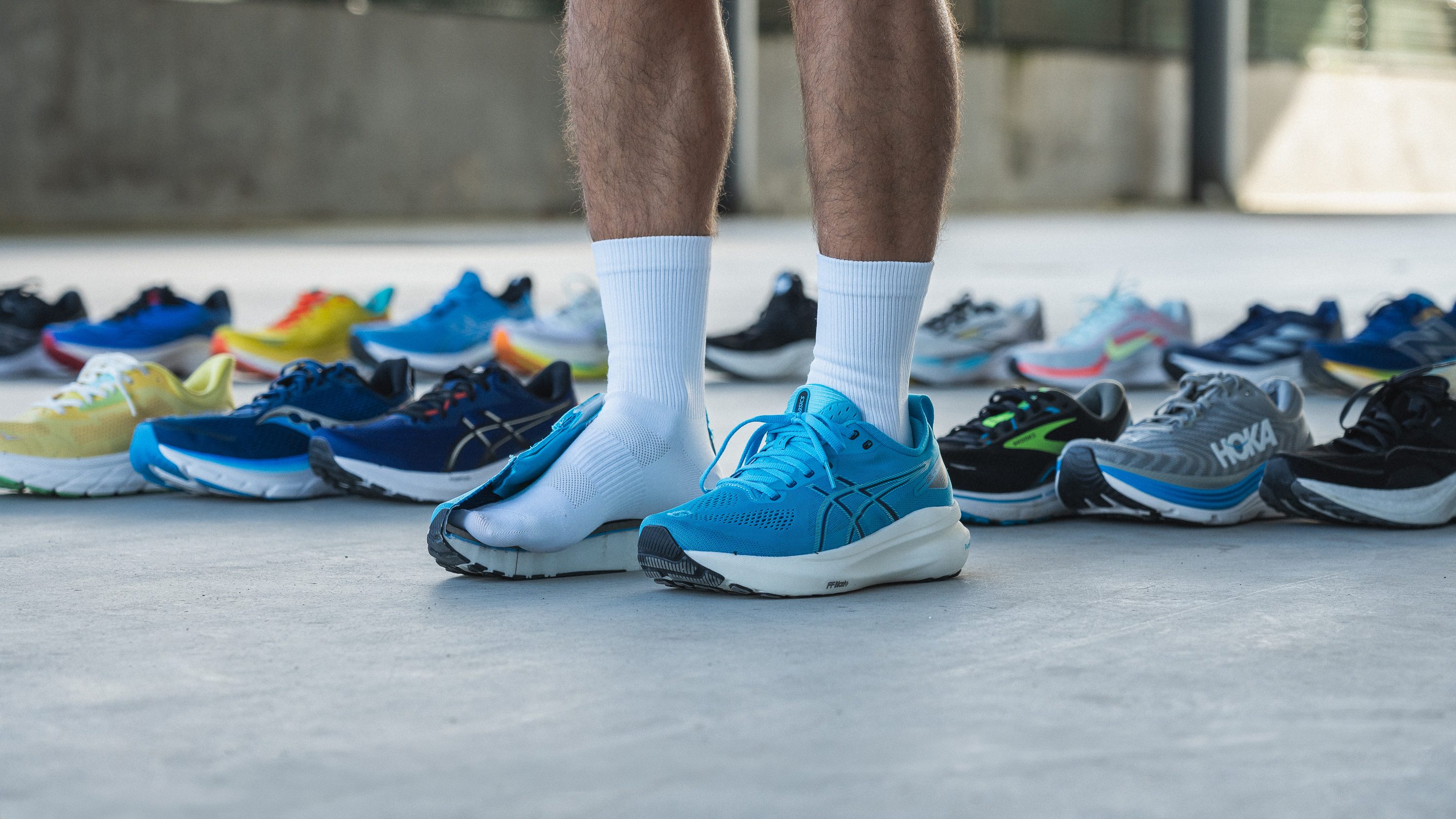
We buy shoes ourselves. We earn commissions when you buy through us, at no extra cost. Why trust us
Stability running shoes are helpful in providing runners with additional arch support, especially if they feel that the lack thereof is preventing a natural and comfortable movement. As a beginner, it could be a worthy investment for you, but make sure to identify first if the features are truly beneficial to your run.
In this guide, we define stability shoes and the top-rated stability running shoes to help you narrow down your choices.
We have tested stability running shoes in our lab and on the test runs, and all our test results, impressions, and insights are summarised in in-depth reviews. Because of such an approach, we're able to highlight the best models in several categories here.
How we test stability running shoes
It is our mission to save you time in picking the best shoe out of 100+ stability running shoes on the market. Here is how:
- We research hundreds of studies on foot biomechanics and running footwear to understand what a good stability shoe is.
- We purchase all the shoes with our own money to prevent bias and brand loyalty.
- We test run each pair before we deliver our feedback.
- With our RunRepeat lab, we cut each shoe into pieces and measure 30+ different parameters that contribute to its performance - from energy return, flexibility, to lace slippage.
And the best stability running shoes make it here.
Best stability running shoes overall



















































What makes it the best?
We believe runners seeking support without compromising comfort will find their match in the Brooks Adrenaline GTS 24. It’s our top stability running shoe because it reassured us in our runs through its GuideRails technology and robust base. Amazingly, our lab results still confirm the comfort it brings through its cushioned heel and flexible midsole.
The GuideRails are located on both sides of the shoe, which helps contain our excessive pronation and movements. Besides this, we discovered a medial post that prevents the arch from collapsing.
Another element that enhances our surefootedness is the firm base. Our durometer shows it’s 19.5% firmer than average, which improves both the shoe’s stability and responsiveness. Despite this, we felt protected from landing impact, notably in its thick 39.0 mm heel cushion.
It felt easy to manoeuvre this shoe thanks to its adaptive midsole. In our bend test, it emerged 19.9% more flexible than average, making it suitable for easy and long runs.
What’s the catch? The shoe has an aggressive 13.5 mm offset that only suits heel-strikers. If otherwise, we recommend looking elsewhere.
Pros
- Stack height upgrade!
- Reliable support
- Breathable mesh with oversized vents
- Price remains unchanged
- Available in 4 width options
- Good durability
- Plush tongue for top comfort
- Ideal for heel strikers
- Foam upgrade to DNA Loft v3
Cons
- Firmer-than-expected midsole
- High drop may feel too steep
- Toebox height is a bit low
- Non-gusseted tongue
Stability running shoes with the best shock absorption
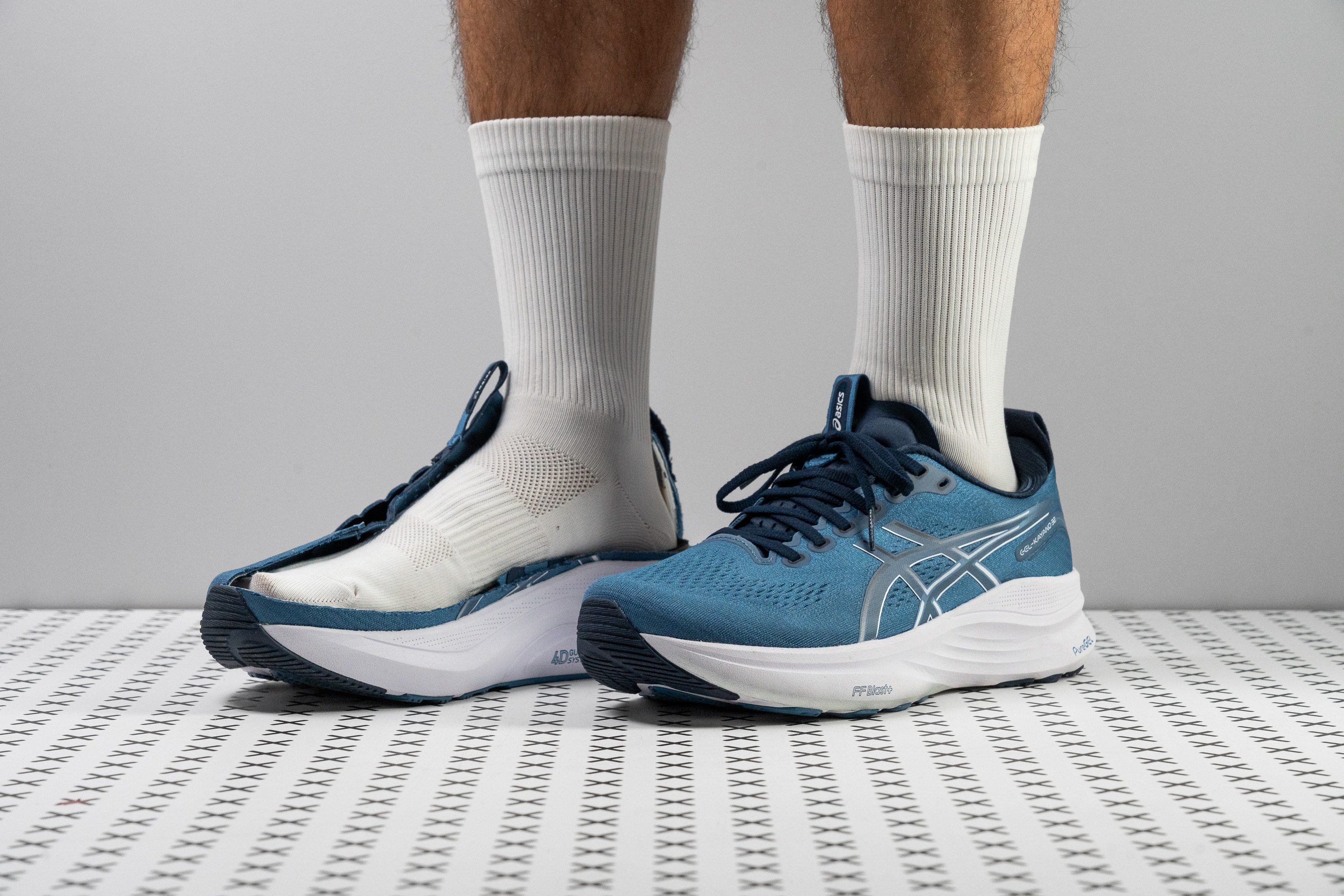













































What makes it the best?
Among the stability running shoes we tested on foot and in the lab, the ASICS Gel Kayano 32 offered top-tier shock absorption. The unusual combination of plush yet steady midsole is tough to match, given its excellent impact protection, high level of comfort, and reliable support.
The GK32 has a crazy heel height of 39.9 mm, much higher than the 34.4 mm average. Not only that, it’s made of impact-dampening foam, proven by our lab test with a high 133 SA rating. This figure suggests gentler landings and less stress on the legs since the average shoe scored 127 SA.
Given its maximalist nature, it’s expected to be wobbly. Yet the GK32 stands out with its subtle yet effective support features such as the 4D Guidance System, the rigid heel, and the wide platform. The heel counter held our ankles so securely, and it refused to be pinched, so we rated it with the maximum 5/5 stiffness score. What also kept each landing safe was the spacious 119.8/97.2 mm base, allowing us to find our balance.
However, this shoe lacked the spark some runners are looking for. With its comfort-focused ride, those who want energy return should look elsewhere.
Pros
- Amazing shock absorption
- Plush and breathable upper
- Made to last
- Dependable for most pronators
- Heavy-duty outsole with excellent grip
- Stable as a table
- Pillow-soft heel padding
- Improved fit
- Excellent build quality
Cons
- Not for soft-foam lovers
- Bad energy return
- Overpriced in Europe
Stability running shoes with the best energy return
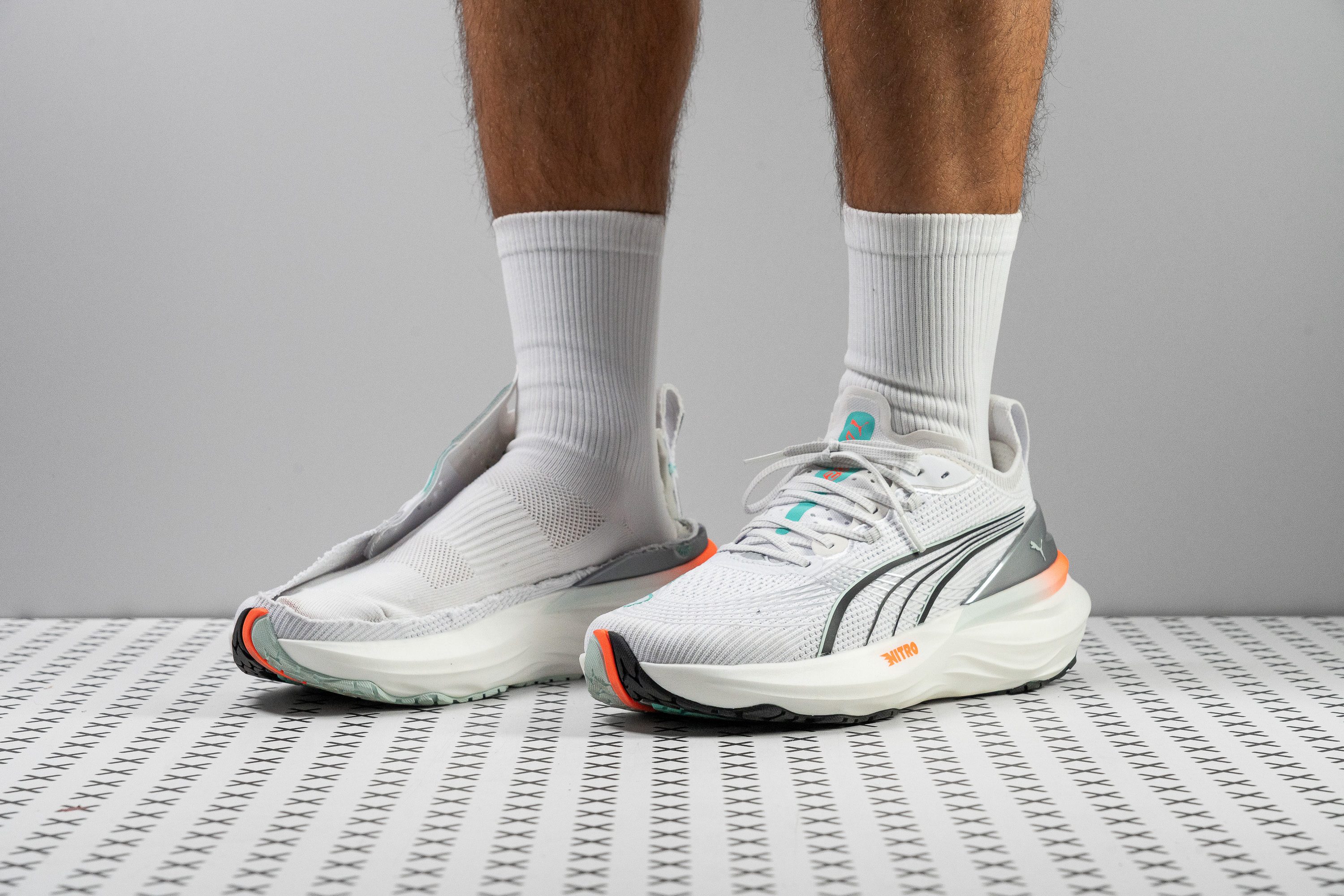











































What makes it the best?
PUMA ForeverRun Nitro 2 redefines stability shoes with its cushion, striking a balance between comfort and responsiveness. It allows us to go insanely fast and far in a sure-footed manner. Our lab results and runs show that it delivers the best energy return among stability shoes.
The springy Nitro cushion is a game-changer, proving that not all stability shoes are dull. Testing for its rebound, we recorded impressive scores of 60.5% in the heel and 63.6% in the forefoot. This pair can take endurance runs with its ability to reduce impact, proven by its exceptional 139/105 SA shock absorption levels.
Its wide base and Run Guide System serve as reinforcements to keep our feet in place. In the heel, we found a plastic insert that guides us forward and prevents lateral movement. Meanwhile, the midsole measures a massive 121.3/97.6 mm, giving our feet more room to land steadily.
Gone are the days when a stable shoe is rigid. In our bend test, the midsole actually shows 28.9% higher flexibility than average, boosting comfort and versatility for a wide range of paces.
Unfortunately, this second version gained weight, which may disappoint fans of this model. If 10.3 oz (291g) is too bulky, we recommend looking elsewhere for a more agile ride.
Pros
- Breathable and comfortable knit upper
- Amazing traction with PumaGrip
- Fair price for its features
- Excellent stability
- Flexible build
- Good durability
- Well designed for heel strikers
- Extra-wide midsole for added support
- Good option for everyday life too
Cons
- Heavier than the previous version
- Rocker mainly benefits heel strikers
- Stability system could be a bit intrusive
- Not the best for wide feet
Best lightweight stability running shoes
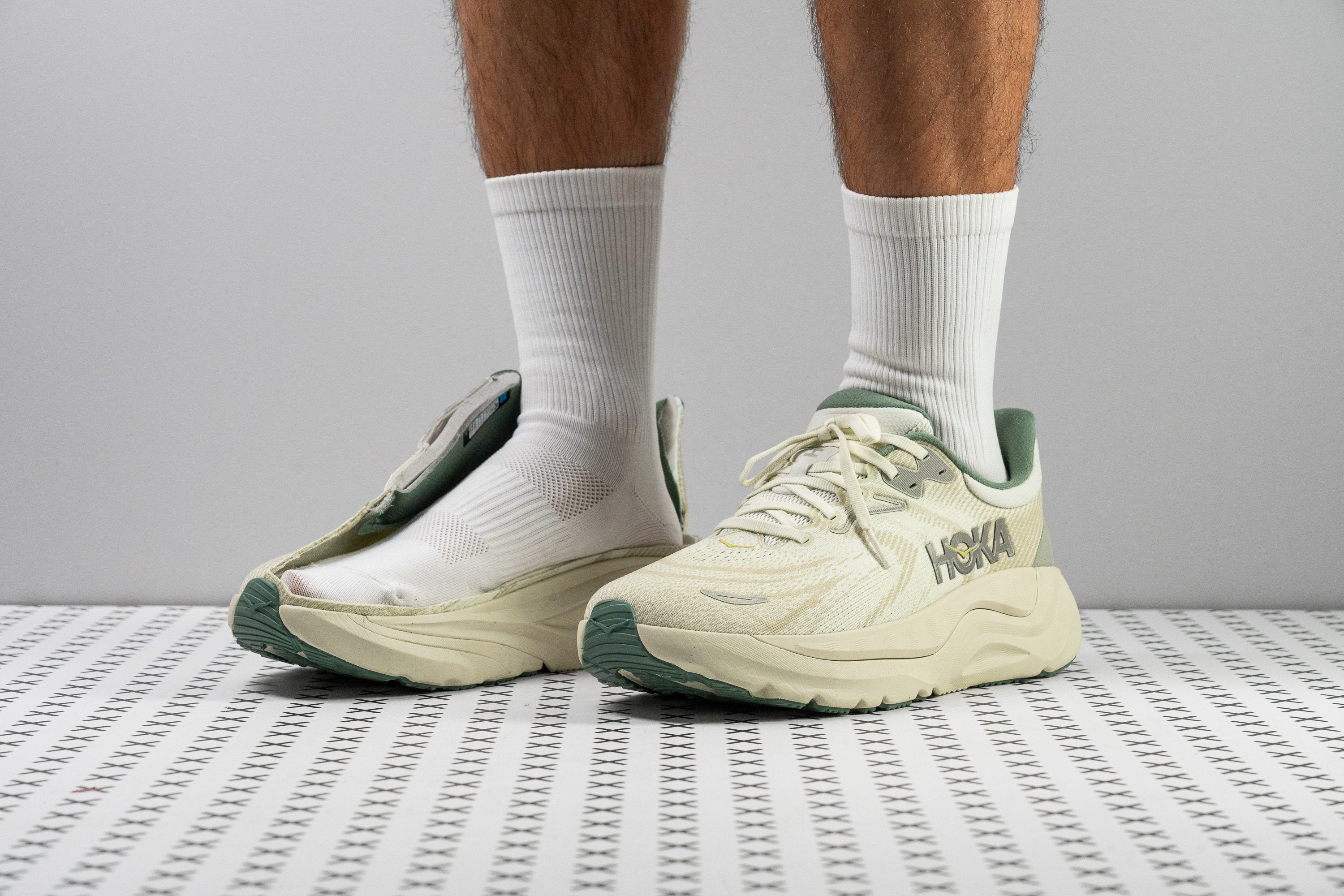











































What makes it the best?
Based on our lab tests and runs, Hoka Arahi 8 is the best lightweight stability running shoe. Why? This basically sums it up: it blends subtle support with generous cushioning all in an airy package.
The Arahi 8 deviates from the typical stability shoe by maintaining a light build. While the average stability shoe in our lab weighs 10.3 oz (293g), this Hoka is significantly lighter at 9.1 oz (259g), even managing to be below the average 9.3 oz (265g) running shoe. It kept our feet and ankles free from the heavy load.
That lightness is even more amazing considering the shoe's substantial stack of 39.4/28.1 mm. We truly felt its comfort and protection during long runs, further evidenced by exceptional shock absorption scores of 138 SA in the heel and 113 SA in the forefoot.
To ensure stability, our lab results reveal Arahi 8's H-Frame technology as its main pillar. Together with its wide 96.3 mm heel, these elements work together to guide our foot alignment without being too intrusive. Because the support is already so effective, Arahi 8 can manage to increase its stack height and cushioned feel.
However, its comfort goes away on a hot day. The double-layer mesh offers poor ventilation, so we can only recommend Arahi 8 in cooler weather.
Pros
- Impressively lightweight for its size
- Strong shock absorption
- Wider fit than previous versions
- Outstanding durability across upper and outsole
- Early-Stage Meta Rocker smooths transitions
- Higher drop suits better heel strikers
- Comfy and plush for everyday use
- H-Frame stability system
- Comfortable heel counter
Cons
- Very poor breathability
- Grip needs to improve
- Still no supercritical foam
- Minor price bump
Best stability shoes for daily running
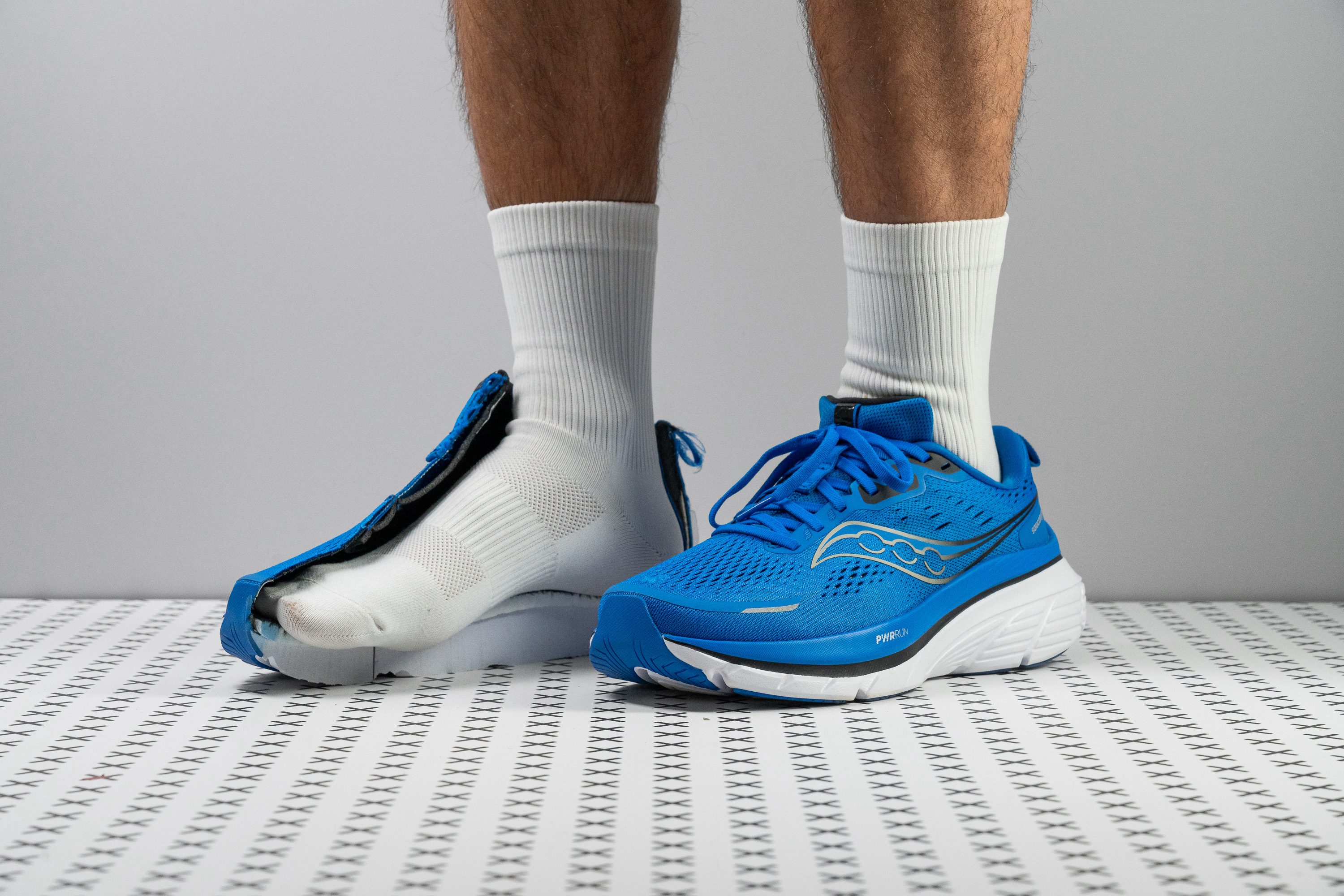

















































What makes it the best?
Saucony Guide 18 blends traditional stability with innovation, serving as a subtle guide without compromising our natural stride. Departing from the conventional stability shoe, our lab shows it offers generous cushioning and flexibility in a lightweight build, earning the best daily trainer title in the stability category.
A stable shoe doesn’t have to be a burden to lift and bend, as proven by Guide 18. At 9.8 oz (278g), it’s lighter than the 10.1 oz (286g) average. Its manoeuvrable midsole, validated by our bend test to be 8.9% more flexible than average, allows for smoother toe-offs, complemented by the rocker design for forward propulsion.
A stark contrast from the usual grounded and firm stability shoes, our calliper reveals an above-average 36.0/27.7 mm, while our durometer reveals a 23.0 HA reading that’s almost as soft as the average. The midsole feels comfortable for any footstrike and distance.
To boost stability, it has midsole sidewalls and sole flares that guide our feet so that we don’t move excessively. The landing base is exceptionally spacious, allowing us to find our footing during off-balance strides. Our calliper shows an extra 7.8/14.3 mm width vs. the average forefoot and heel.
Guide 18 balanced support and comfort well but missed the energy return needed for tempo runs. We recommend checking alternatives for runners who prefer a faster shoe.
Pros
- Upper now has exceptional breathability
- Stable yet non-restrictive ride
- Cushioned enough for long runs
- Handles walking too
- Impressively wide platform
- PWRRUN PB insole
- Secure and comfortable lockdown
- Excellent heel rocker design
Cons
- Too much exposed foam on outsole
- Feels bulky and not agile
- Midsole runs a bit firm
- Midsole runs a bit firm
Best stability running shoes for wide feet
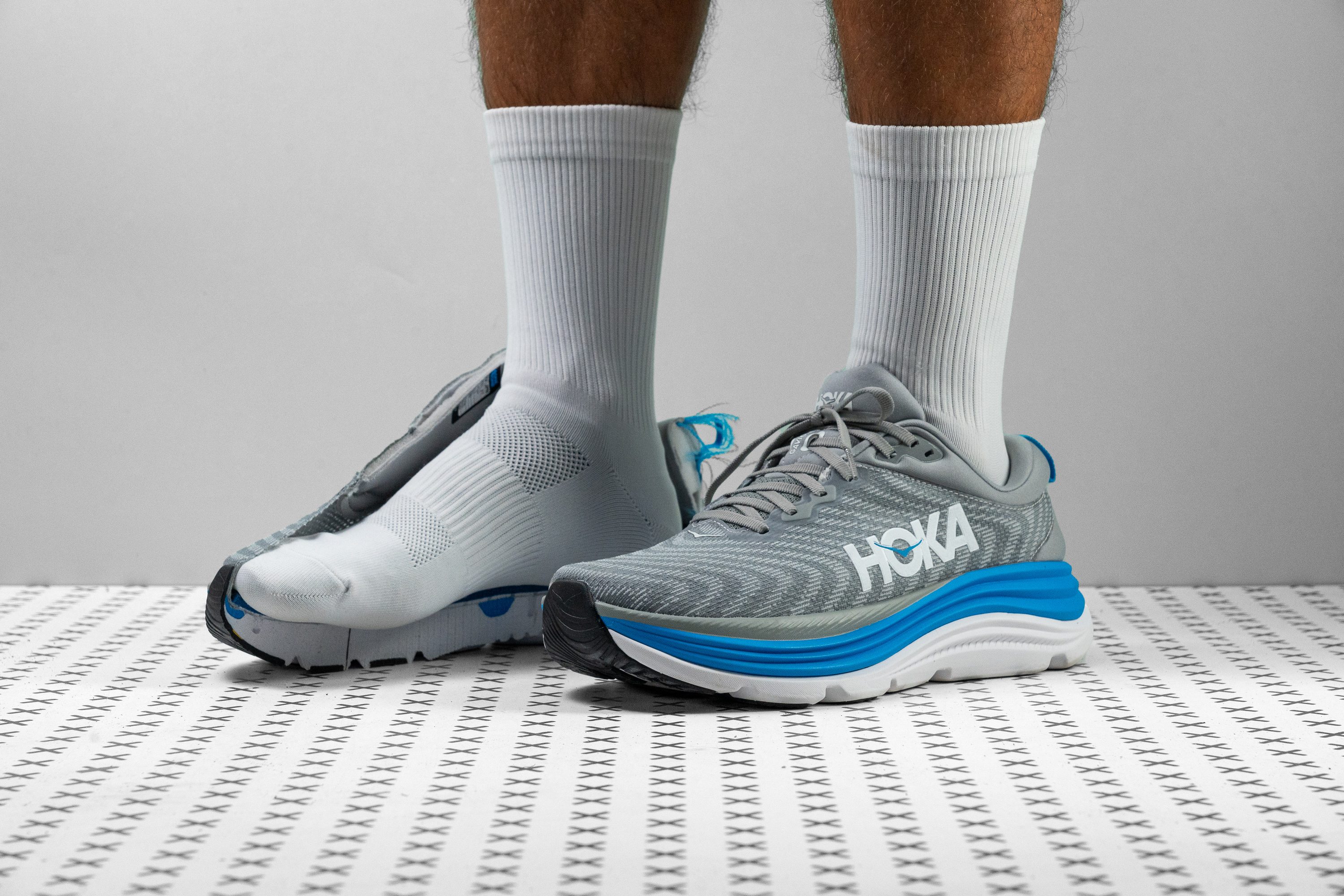


















































What makes it the best?
The Hoka Gaviota 5 feels far from restrictive, giving us lots of breathing room. Lab results show it features wide dimensions and an airy upper, boosting both comfort and support, making it our best for wide feet stability running shoe.
We created a gel mould to confirm the shoe’s forgiving fit, and measured a massive 99.7 mm at the balls of our feet. Compared to the average, it has 4.8% more space, making it suitable for runners with broad feet or bunions.
The well-ventilated upper adds to its refreshing sensation. In our smoke test, the air we pumped in escaped immediately, so we rated it with the maximum 5/5 breathability score.
The platform has generous dimensions too, boosting Gaviota 5’s stability. We measured it at a massive 125.1/106.6 mm, enhancing a well-planted feeling. The midsole features the H-Frame, which adds structure to the shoe. The stiffness makes it twist-resistant, proven by its 4/5 torsional rigidity rating in our manual assessment.
However, Gaviota 5 features a minimal 2.2 mm drop, making it less ideal for rear strikers. If this low offset is too daunting, we recommend going for a trainer with a steeper heel drop.
Pros
- Remarkably stable
- Breathable and comfortable upper
- Lightweight for its size
- Good stability option for forefoot strikers
- Ideal for wide feet
- Excellent for long runs
- Excellent for long runs
Cons
- Low drop might pose issues for heel strikers
- Performs poorly in colder conditions
- Not for narrow feet
- Midsole feels flat
Best budget running shoes for stability
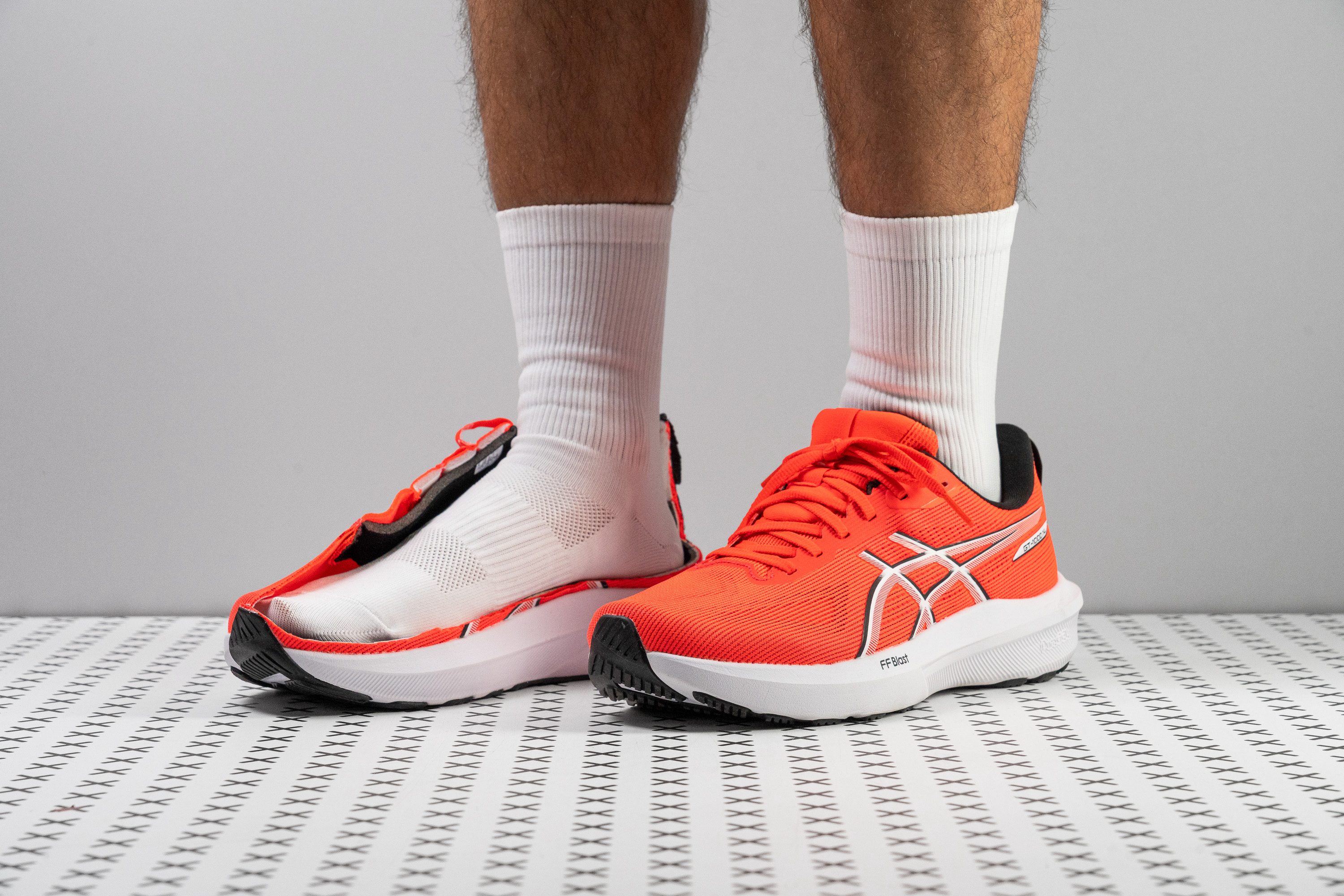













































What makes it the best?
ASICS GT 1000 14 redefines the old-school stability shoe, focusing on comfort and flexibility. It offers undeniable support and a high-quality outsole for the affordable price of £110 vs. the £150 average running shoe in the lab, making it our best budget pick from the stability line.
Each footfall lands on the shock-absorbing PureGEL heel, erasing any discomfort. The GT 1000 14 feels great for daily use because of its loose midsole. In terms of flexibility, it boldly exceeds the average by 18.0% in our bend test, making it feel natural and smooth.
The AHAR outsole strikes the perfect balance between grip and durability. Its high friction coefficient of 0.50 confirms all-season traction. Meanwhile, our Dremel only manages to shave off 0.7 mm of material vs. the 1.0 mm average, cementing its durability.
Gone are the days when stability shoes were heavy, since this pair boasts a light 9.6 oz (272g) weight. GT 1000 14 offers reliable support through its 3D Guidance System, midsole sidewalls, and broad 94.8 mm heel. In our torsional rigidity test, it received a high 4/5 score, the perfect amount for a stable daily trainer.
Unfortunately, the midsole falls short in energy return. Those who don’t want a dull ride should find a more responsive pair.
Pros
- Supercharged stability
- Ideal for heel strikers
- Still offers amazing value
- Fuss-free, durable design
- Improved outsole traction
- Comfortable for everyday wear
- Great step-in feel
- Improved foam from v13
Cons
- Bad breathability
- Still lacks energy return
- Boring ride
This guide is here to educate and explain shoe design, not give medical advice. If you’re injured, experiencing any pain, or not sure whether overpronation is the cause of the pain, we recommend visiting a specialist.
Who stability shoes are for?
During running, when we land on the surface, our arch collapses to absorb the shock, and the rearfoot rolls inward at the ankle. This is pronation and it’s completely normal and necessary when running.
However, some ankles roll far too inward. This is overpronation and the majority of runners overpronate.
Stability running shoes are made for overpronators because they use different technologies to help with overpronation. This means they stabilise the landing and correct the movement (to a certain degree) so that the excessive inward movement is stopped and the heels get the necessary support.

There are different levels of overpronation, mild, moderate, and severe, and the more runners overpronate, the more stability is needed.
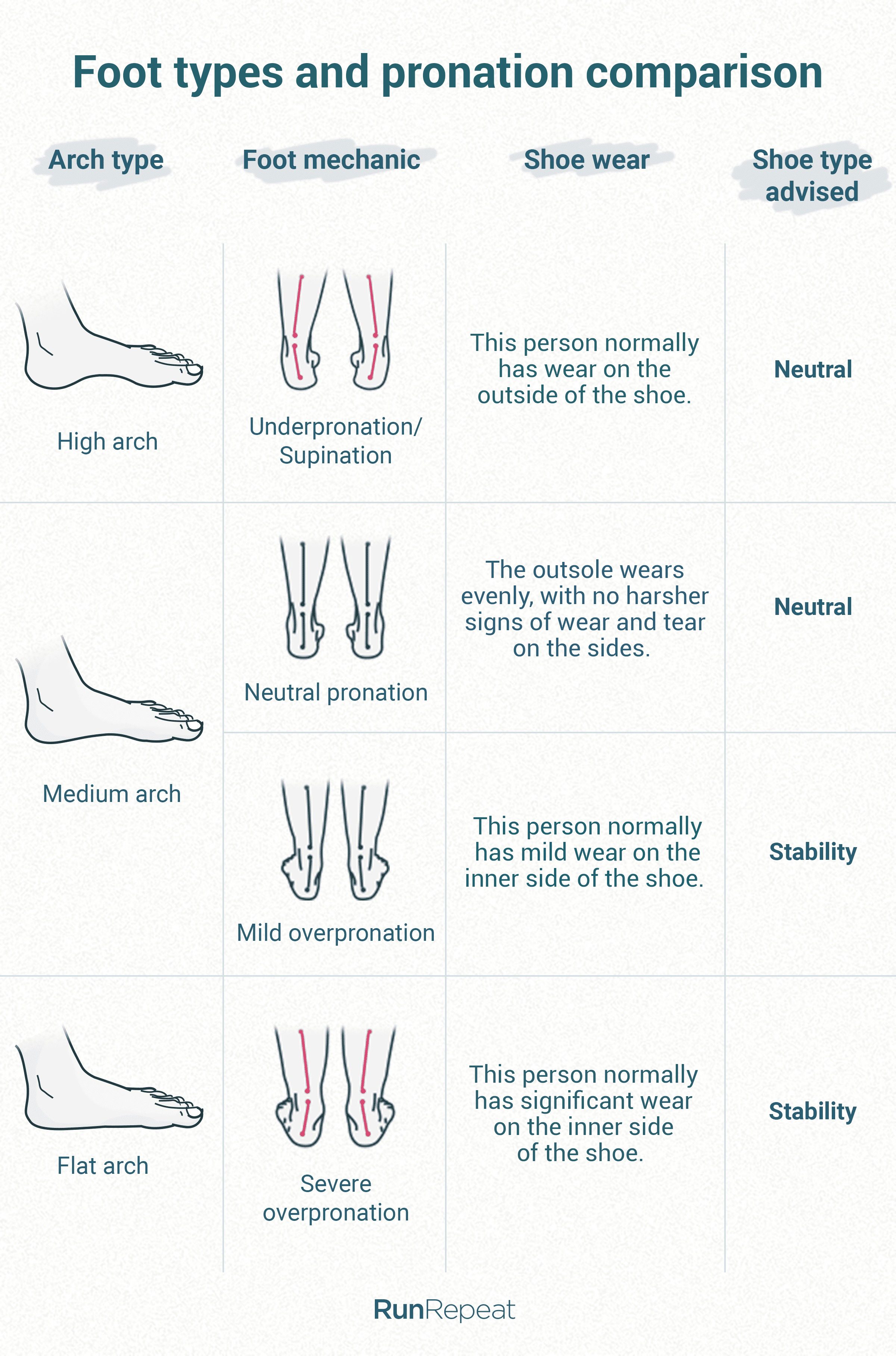
In some cases, when overpronation is severe, runners use orthotics and motion-control shoes, although motion-control shoes have become a thing of past and we mostly focus on stability shoes.
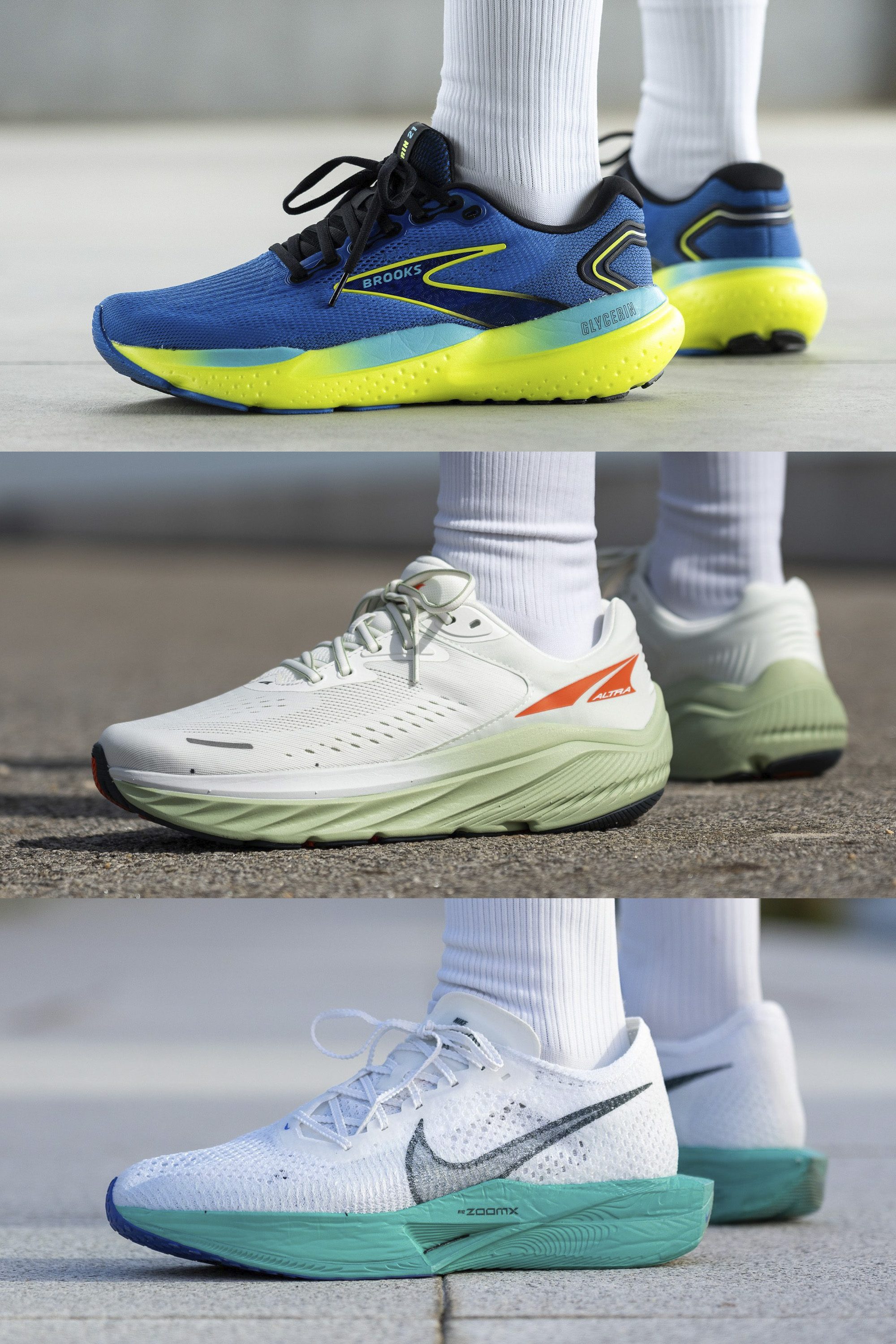
With the rise of new technologies, we’re seeing fewer motion-control shoes and more modern stability running shoes.
It’s also important to note that race shoes rarely offer any stability elements. They can have a very tall and narrow base, ridiculously thin heel counters, etc. This is because, at faster workouts, runners usually require less stability.
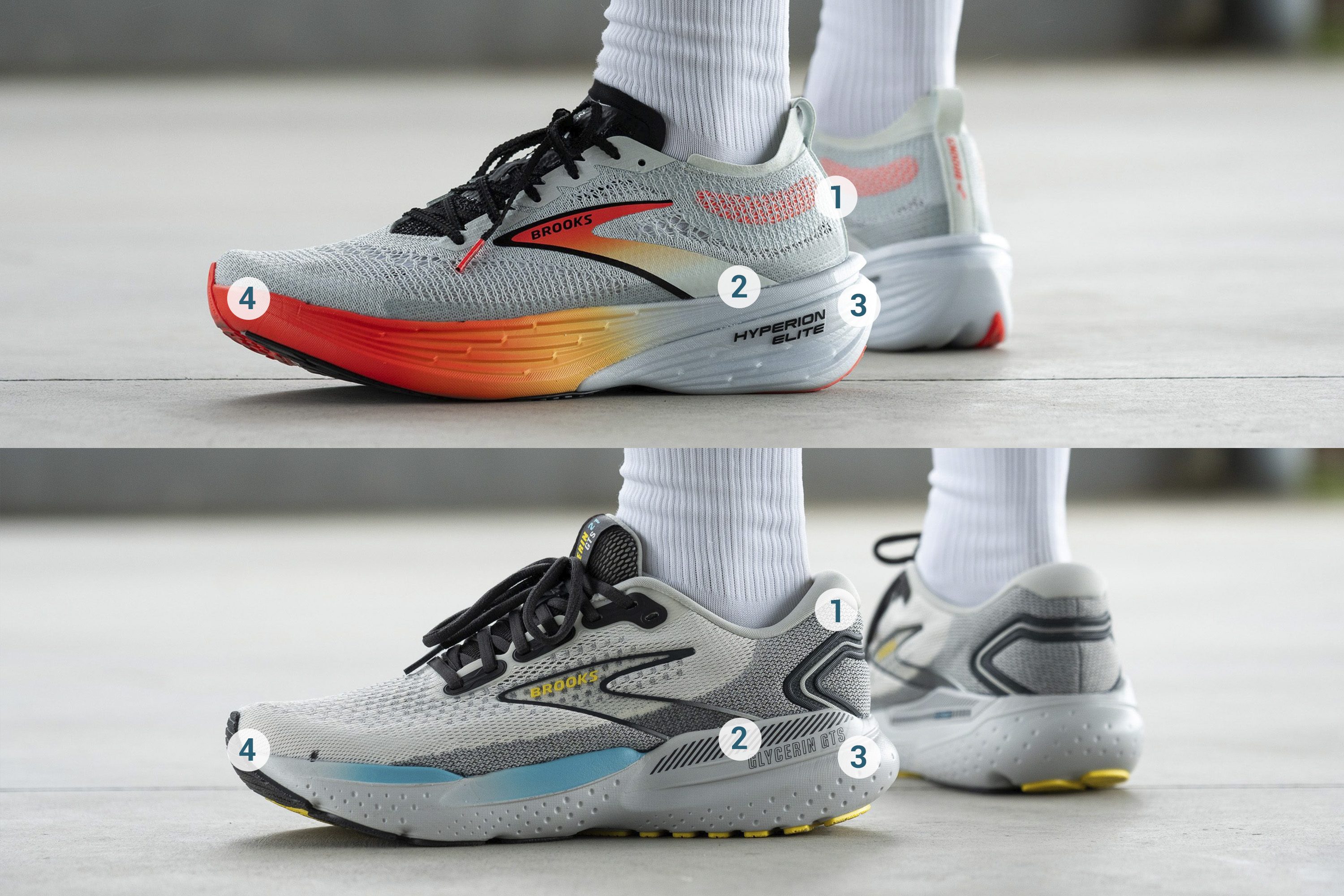
1. soft sock-like heel vs a stiff and padded heel counter
2. no side walls vs. GuideRails present
3. no heel flare vs. a present heel flare
4. less ground contact vs. more ground-contact in the outsole
However, when doing longer runs, our feet get tired, and we tend to land harder and even change our strike (from forefoot to heel). It’s when we need more stability, and that’s why we have more stability shoes in the realm of daily trainers.
| If you’re new to this topic of pronation, we wholeheartedly recommend our in-depth guide Pronation 101: Running Shoe Choices, DIY Analysis, Injuries. |
How to recognise stability shoes
Stability shoes implement some trademarked technologies developed by different brands and they implement different geometry elements (not trademarked).
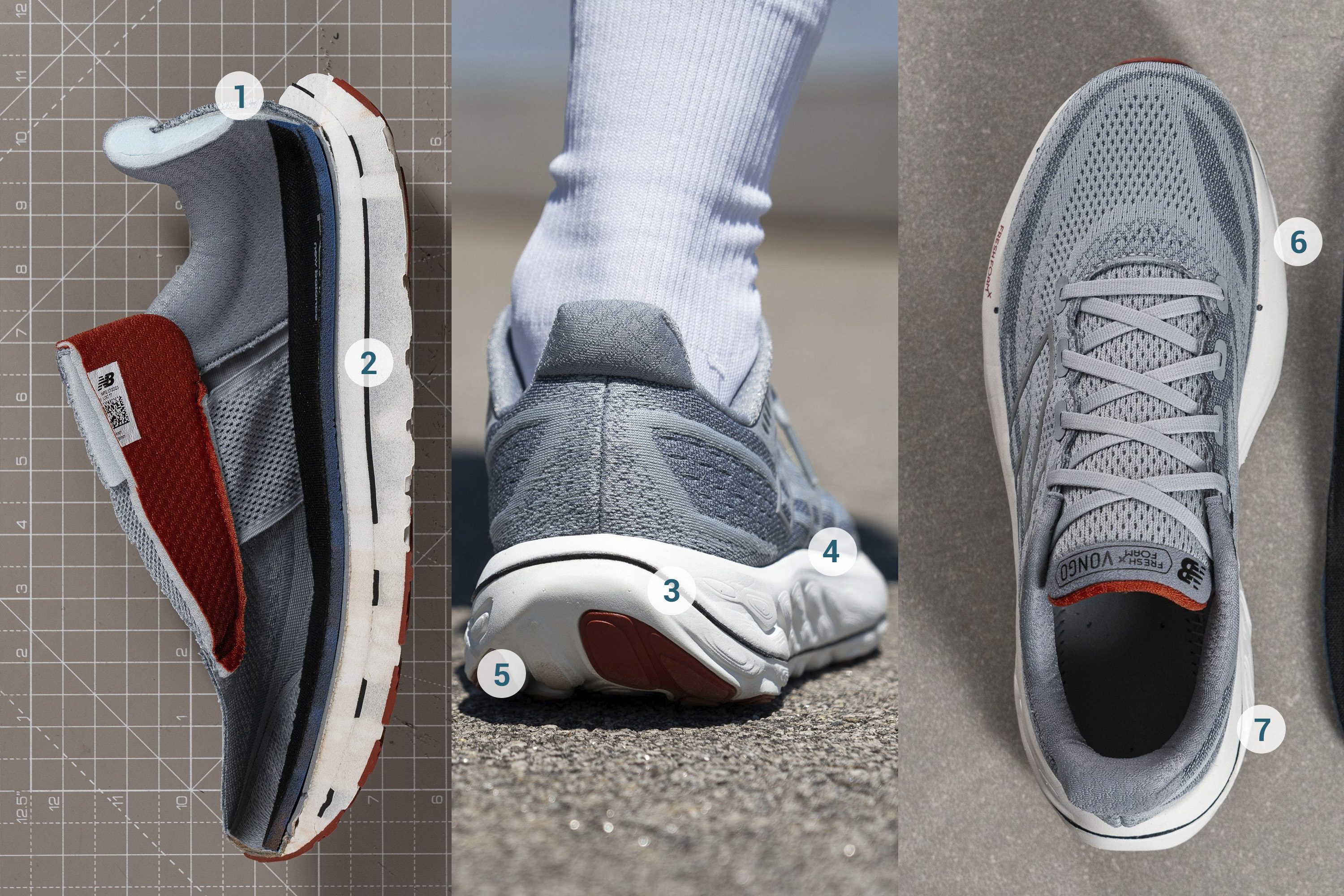
2) dual density midsole (softer above the firmer) 3) heel bevel 4) side walls
5) stiff and wide base 6) forefoot sole flare 7) heel sole flare
But, when it comes to visual inspection, there are quite a few things you can pay attention to to understand whether the shoe is neutral or a stability one. Stability shoes often feature 2 or more of the following geometry elements listed below.
Medial post
Medial post is a piece of firmer foam or plastic located on the medial (inner) side of the shoe and its role is to prevent the excessive inward roll of the ankle and collapsing of the arch. It can also be somewhat longer and look like a frame.

Dual-density midsole
It can appear as a firmer foam on the inside or under the arch, in the form of trademarked technologies like Hoka’s J-frame or H-frame, or brands simply get creative and combine different midsole densities to increase the stability.
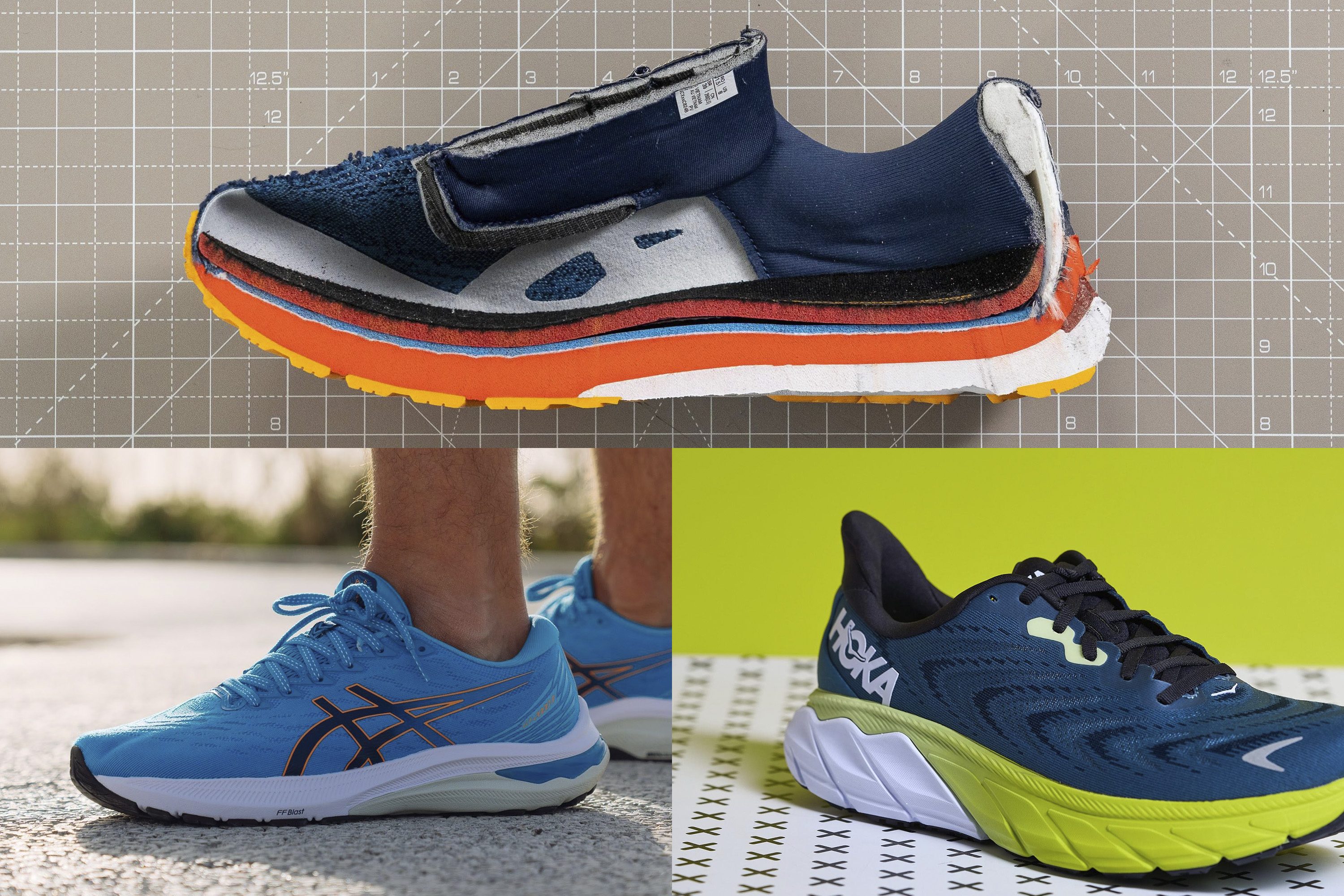
In our lab, we measure the softness of both midsoles present (explained more below).
Stiff and padded heel counters
The stiffness of the heel counter allows for a heel to stay put and not to wobble. The more stability, the merrier! And padding usually helps with the lockdown. Usually only race shoes have no padding and insanely soft heel area.
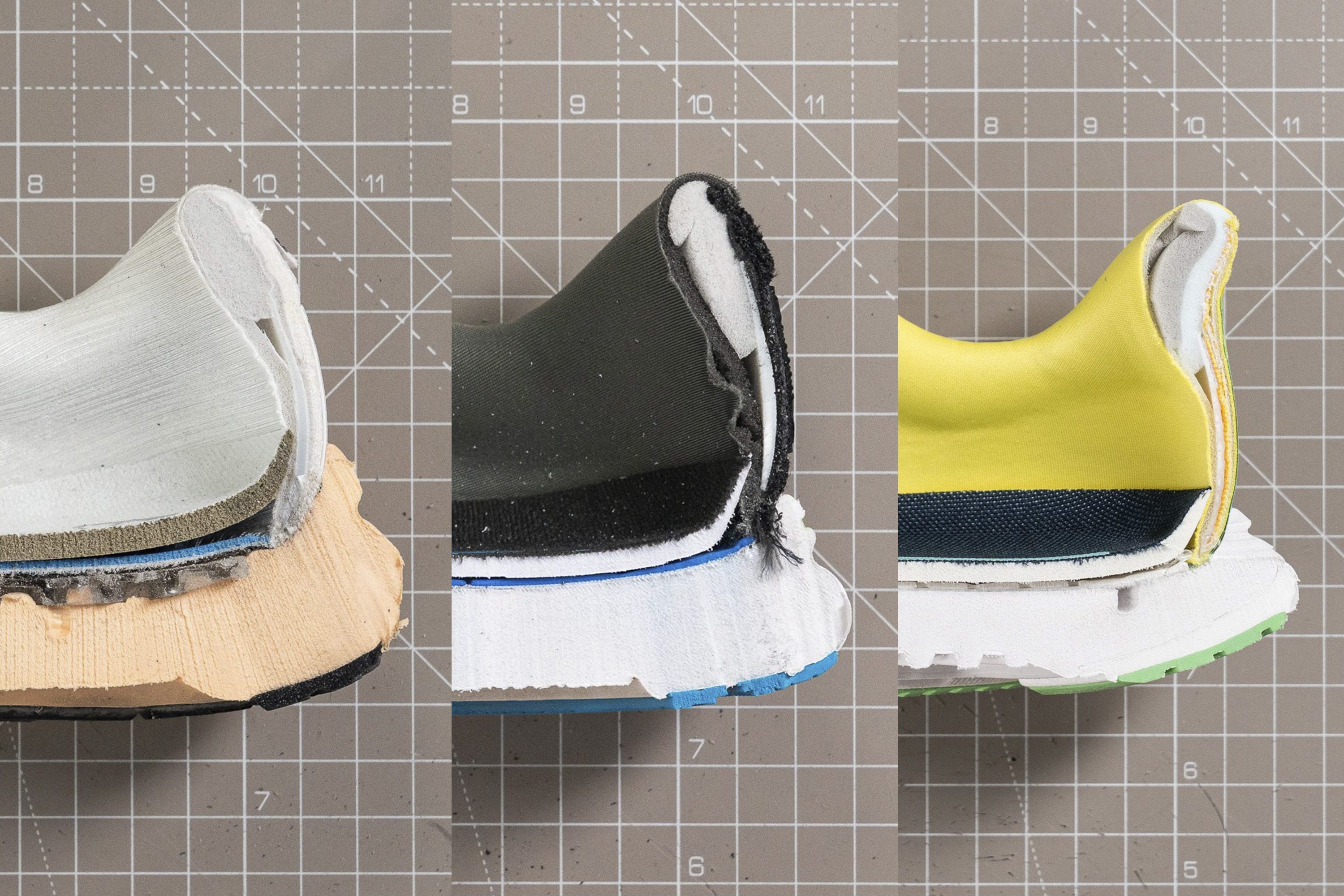
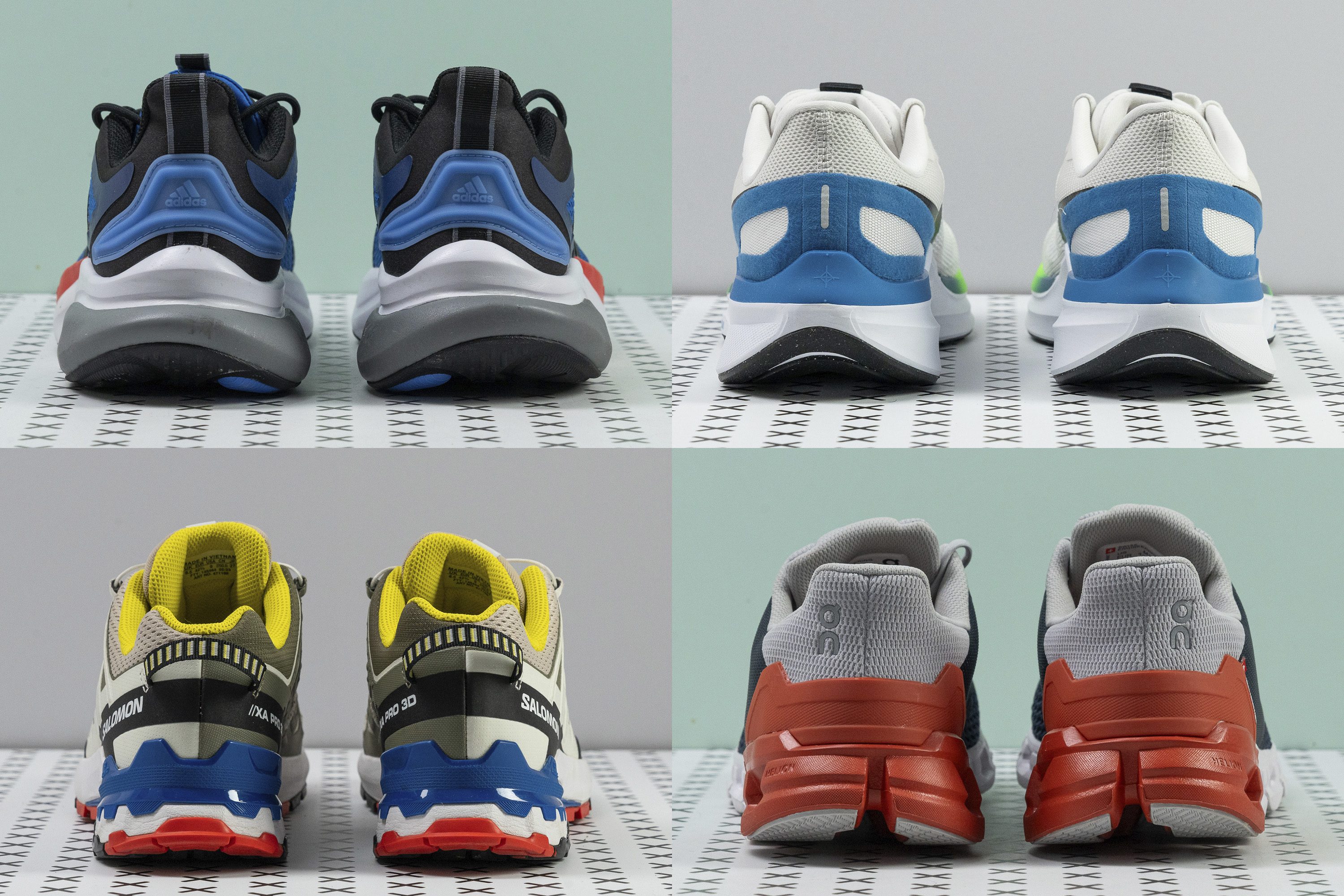
In our lab, we assess the stiffness of the heel counter by pushing it and squeezing it. We rate it on a 1-5 scale, where 5 is the stiffest.
These heel counters are not just stiff but also padded. They cradle the heel nicely to make it super locked in and stable.
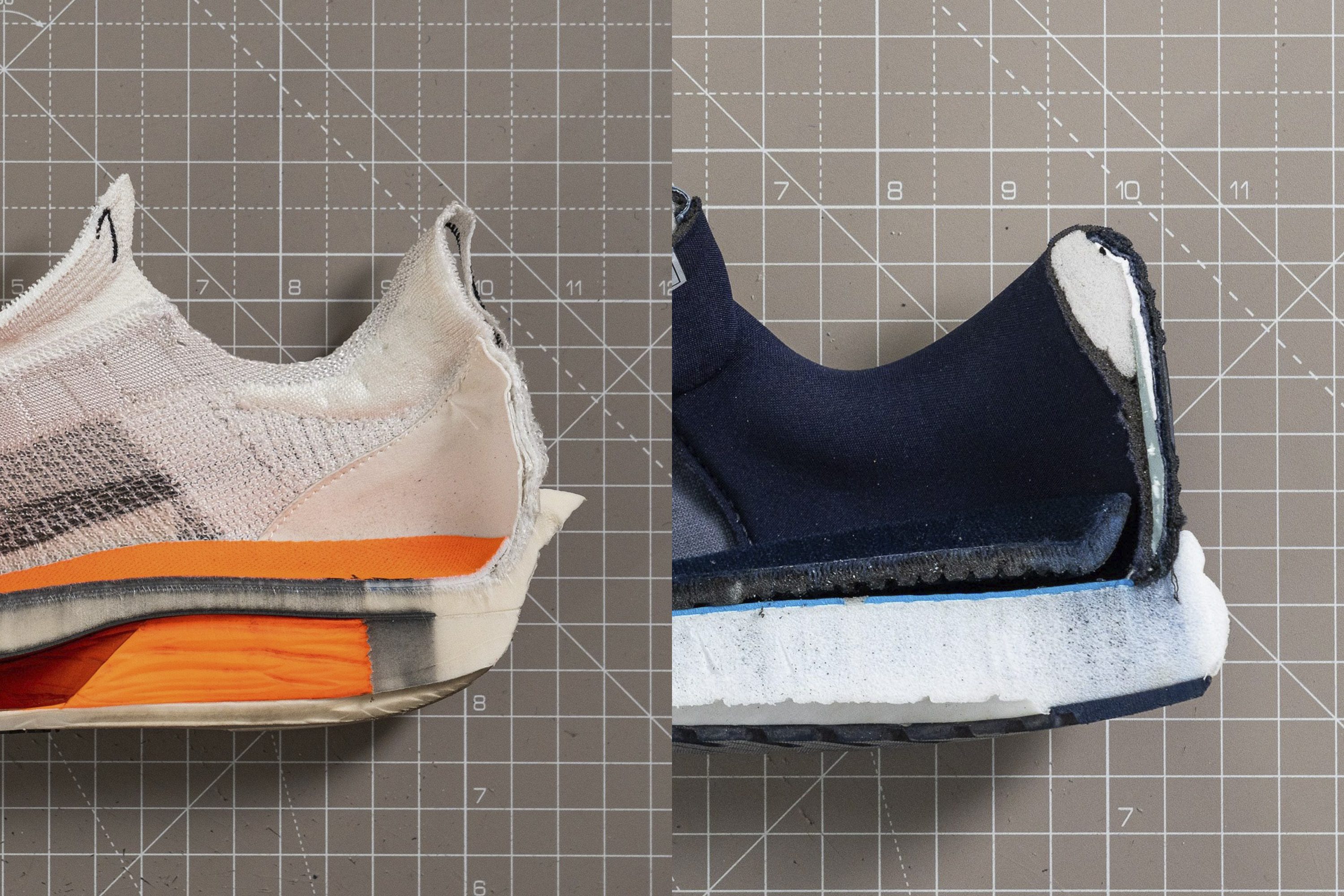
| If this topic is of interest to you, we’ve put together an in-depth guide on heel counters: The role of heel counters in running shoes. |
Stiffer base
The base often has plates or rods in the midsole or is simply stiffer, thanks to the amount of rubber in the outsole and the density of the foam in the midsole. In RunRepeat shoe lab, we test a) longitudinal stiffness and b) torsional stiffness.
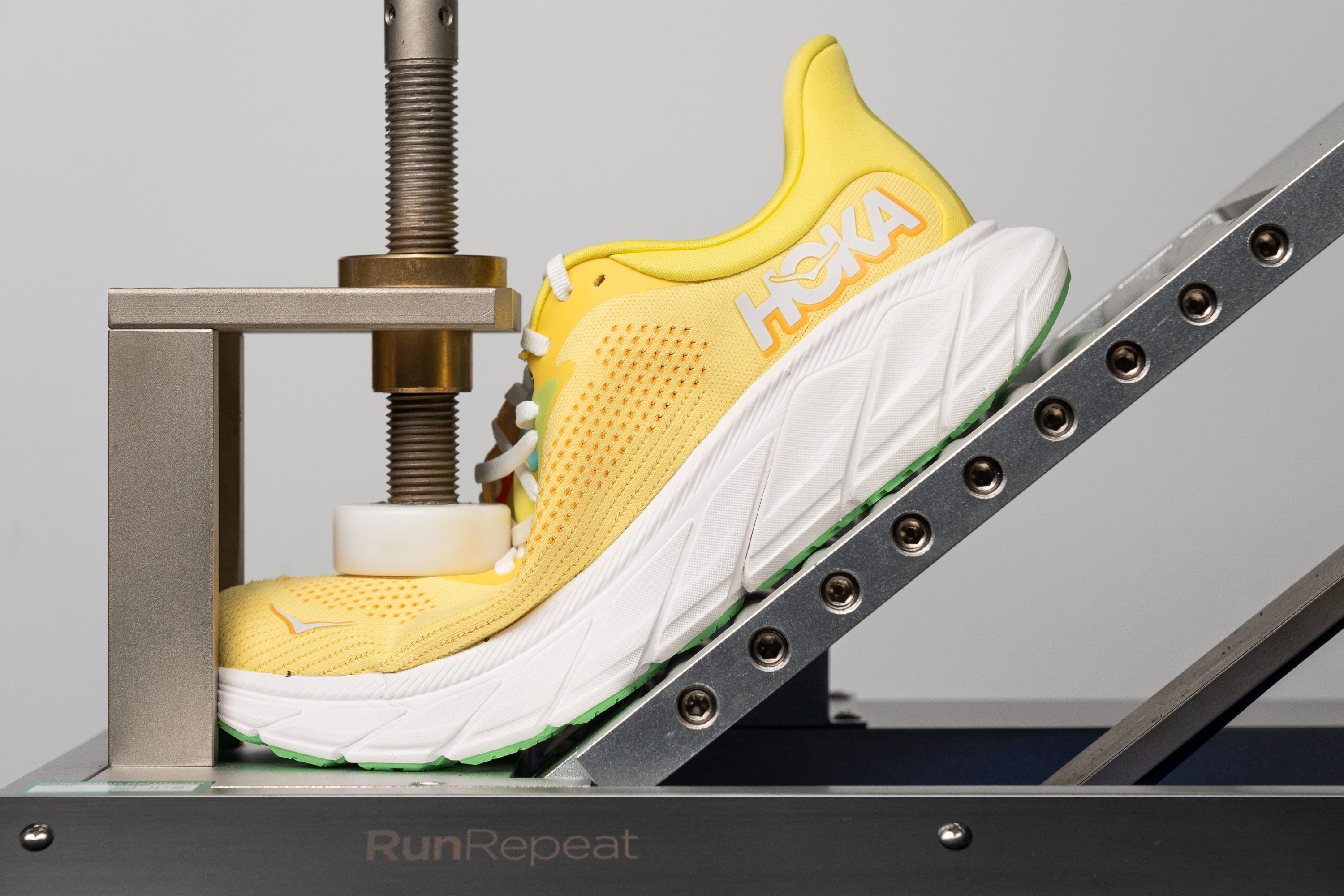
The higher the number in Newtons, the more force was needed to bend the shoe to 30 degrees, which means it is stiffer. Lower numbers indicate more flexible shoes.
When it comes to torsional rigidity, we assign each shoe a rating on a 1-5 scale, where 5 is the stiffest.
Wide base
This is needed because extra width ensures planted landings. Basically, we’re avoiding narrow and high platforms, as you’d see in some race shoes. The wider, the better!
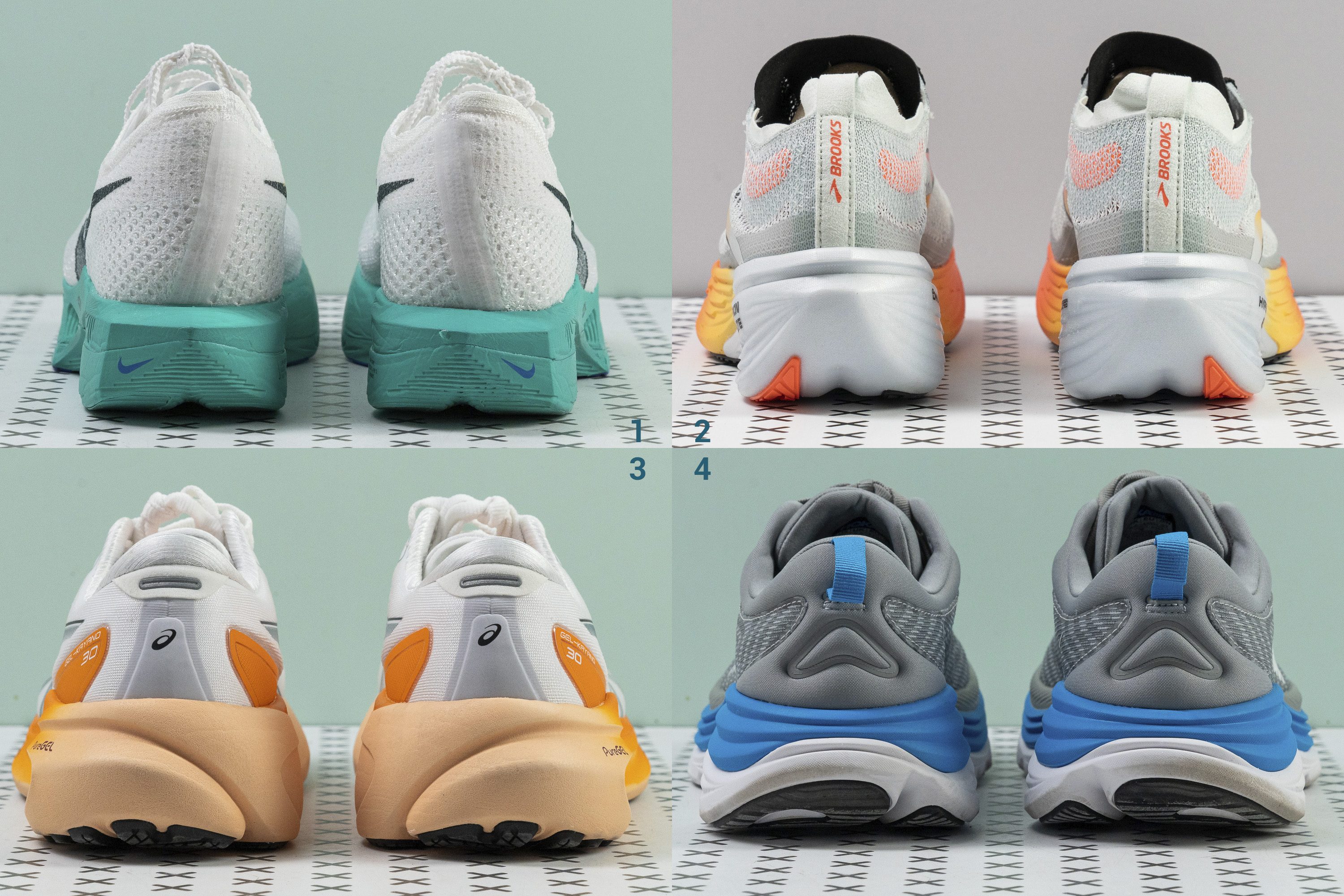
While the width of the base is more important in stability running shoes because overpronators usually land on the heel, in our lab we actually measure the width of the base in 2 places: at the forefoot and at the heel.

Full-ground contact outsole
It helps a lot when it comes to that secure feel. Some shoes have cutouts in the outsole to lose weight or to improve flexibility. That is, of course, not a bad thing, but when it comes to stability, more ground contact is better.
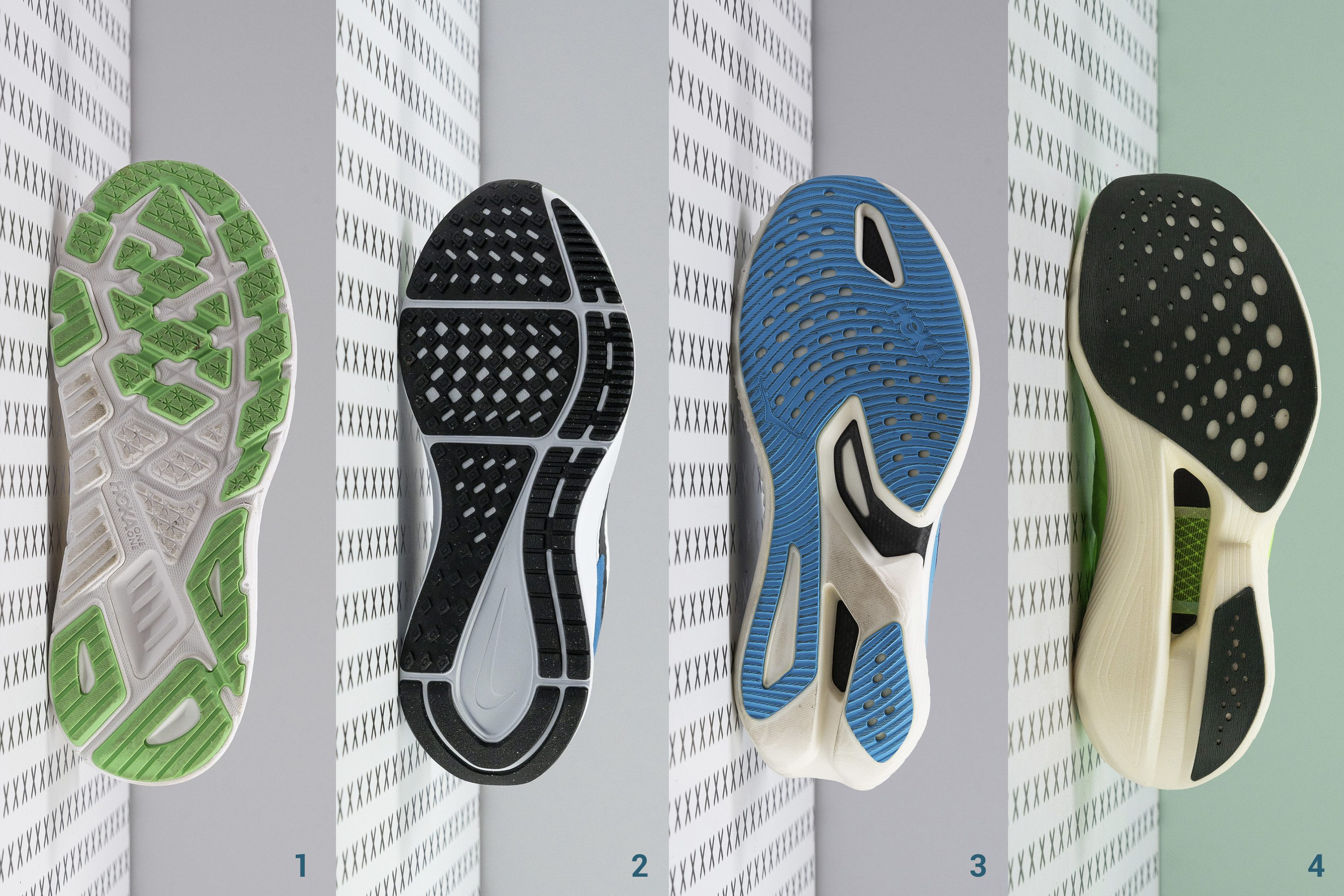
Side walls
The midsole is extended upward to create a “wall” which provides more structure and keeps the foot locked in.

These sidewalls can create the illusion that the heel drop is smaller. But, no need to worry because we cut shoes in half and follow WorldAthletics guidelines when it comes to measuring stack heights. No sidewalls are tricking us!
Heel bevel
Heel bevel is a curved back of the heel that reduces the amount of stress in the tibialis anterior muscle, and it improves the transition for heel strikers. The more it’s bevelled, the faster the forefoot hits the ground.

Sole flare
This is a protrusion that can appear on the medial and lateral sides. For heel strikers, it’s important that it’s present at the heel. This means that the protrusion (midsole) becomes wider than the upper.
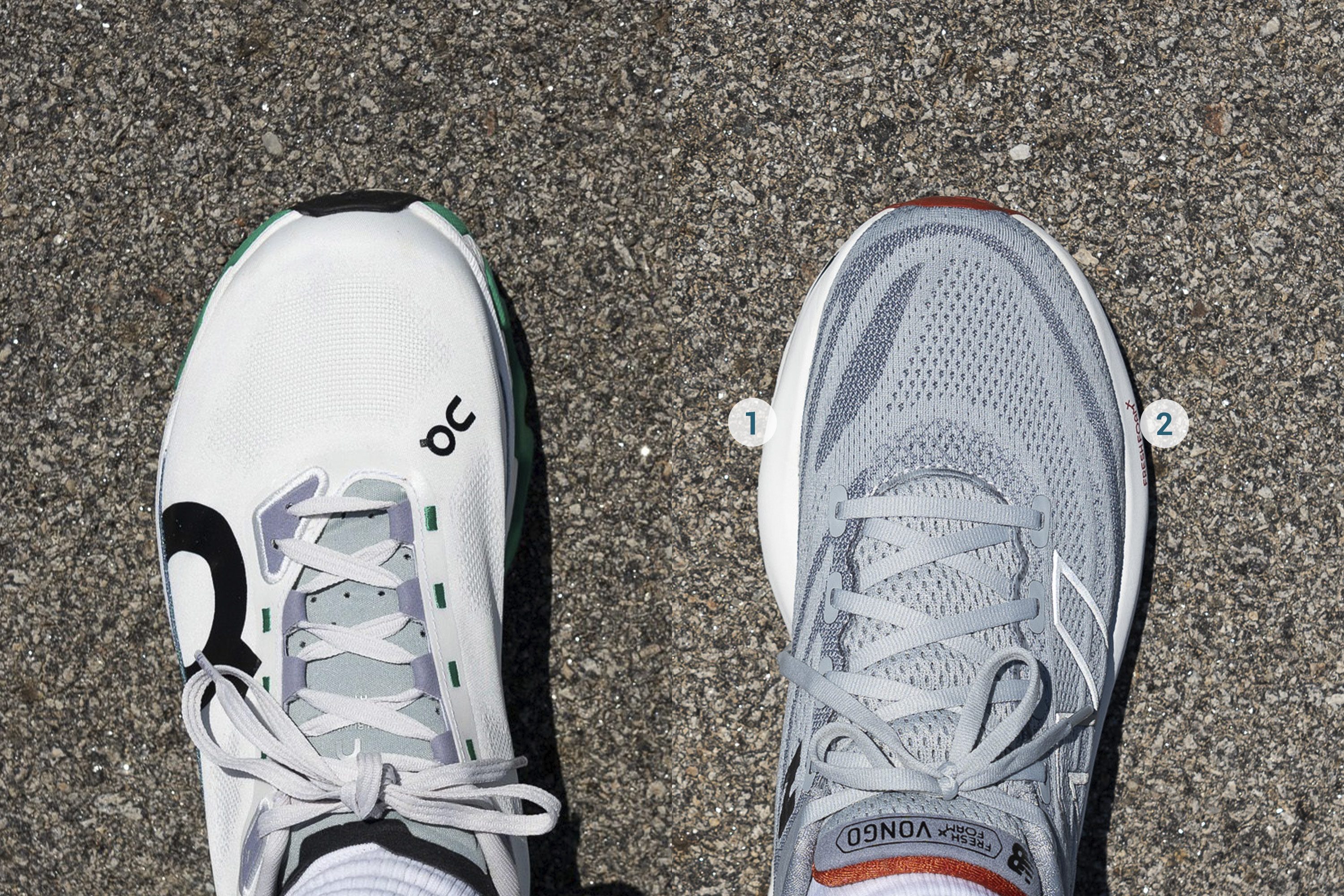
Those who pronate at the heel should look for a medial heel flare. Those who pronate at the forefoot can look for medial forefoot flare.
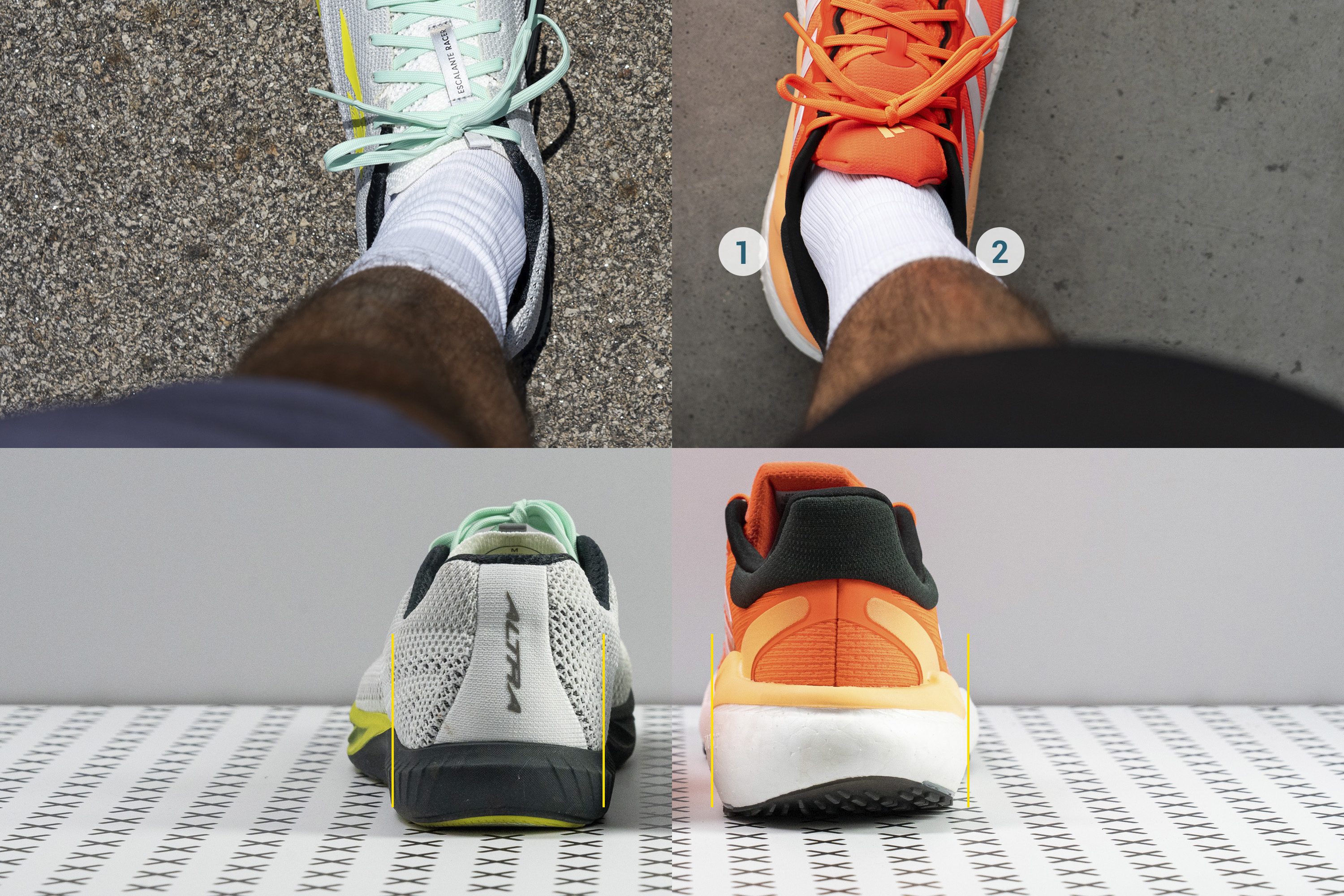
Structural upper overlays
These overlays help with support and stability by ensuring a superb lockdown, especially around the midfoot. They are present on the upper and can have different shapes and stiffness levels and usually feel extra secure.
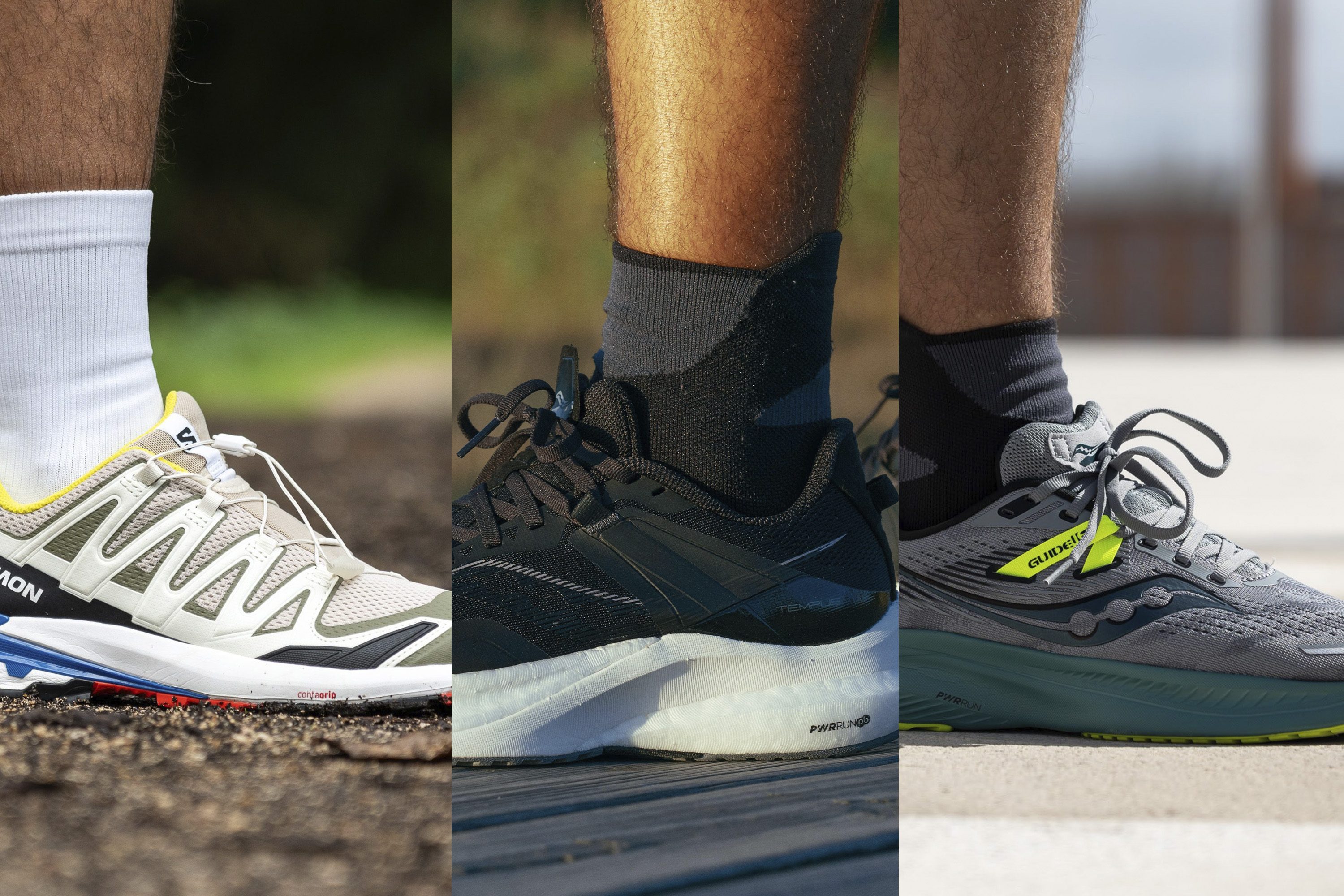
Brands' trademarked technologies found in stability shoes
There are many technologies used to help overpronators run better and we will mention more popular ones below.
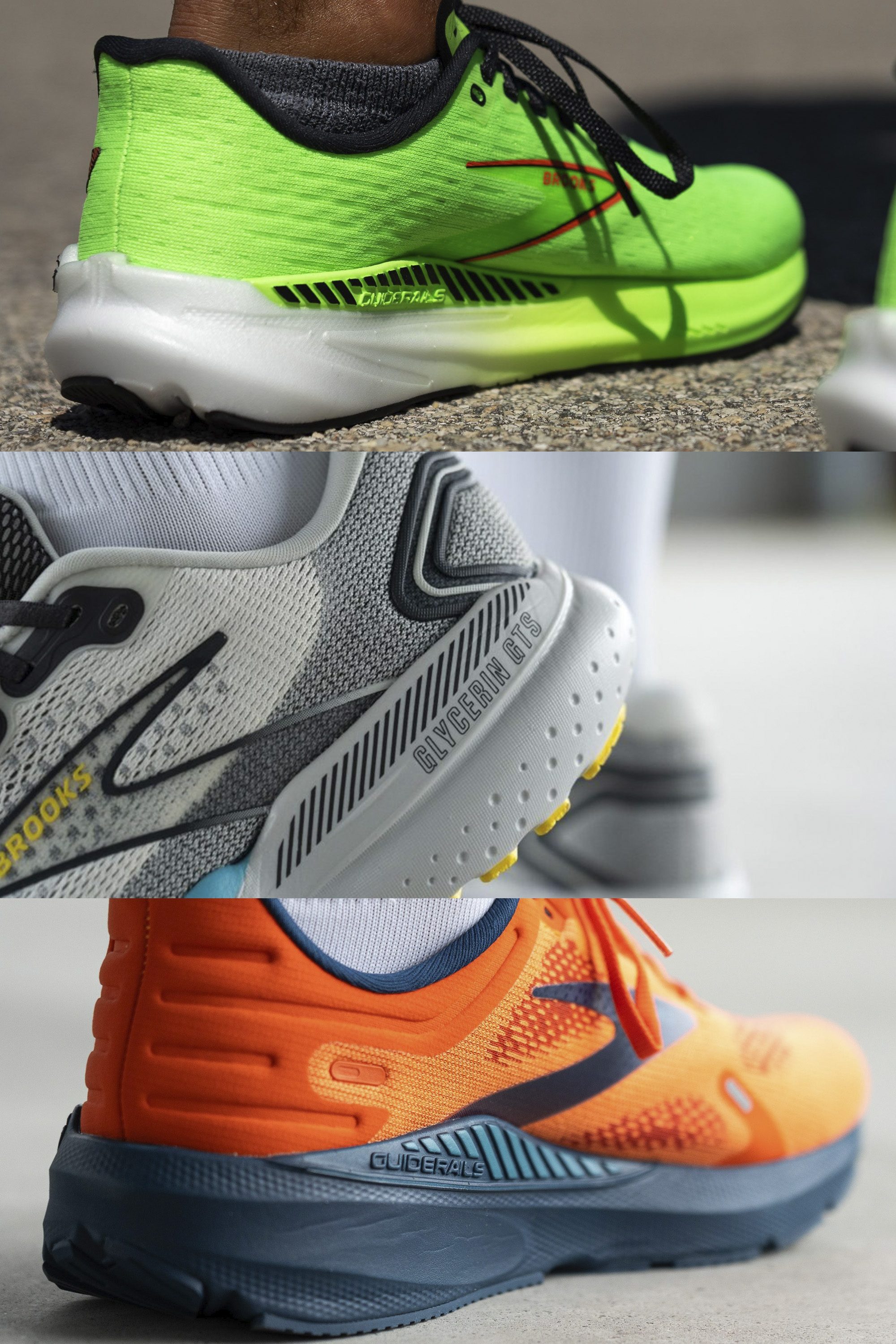
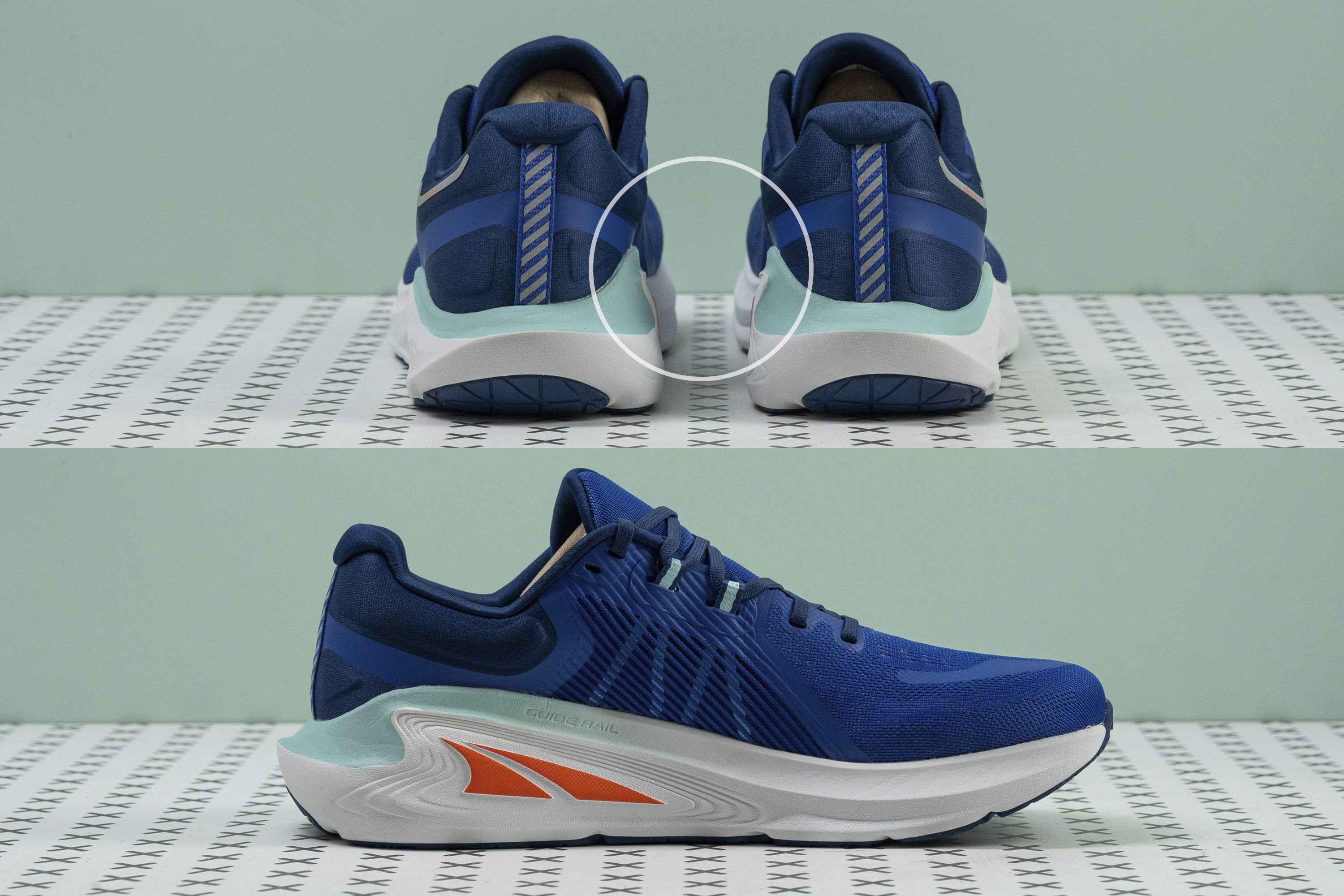
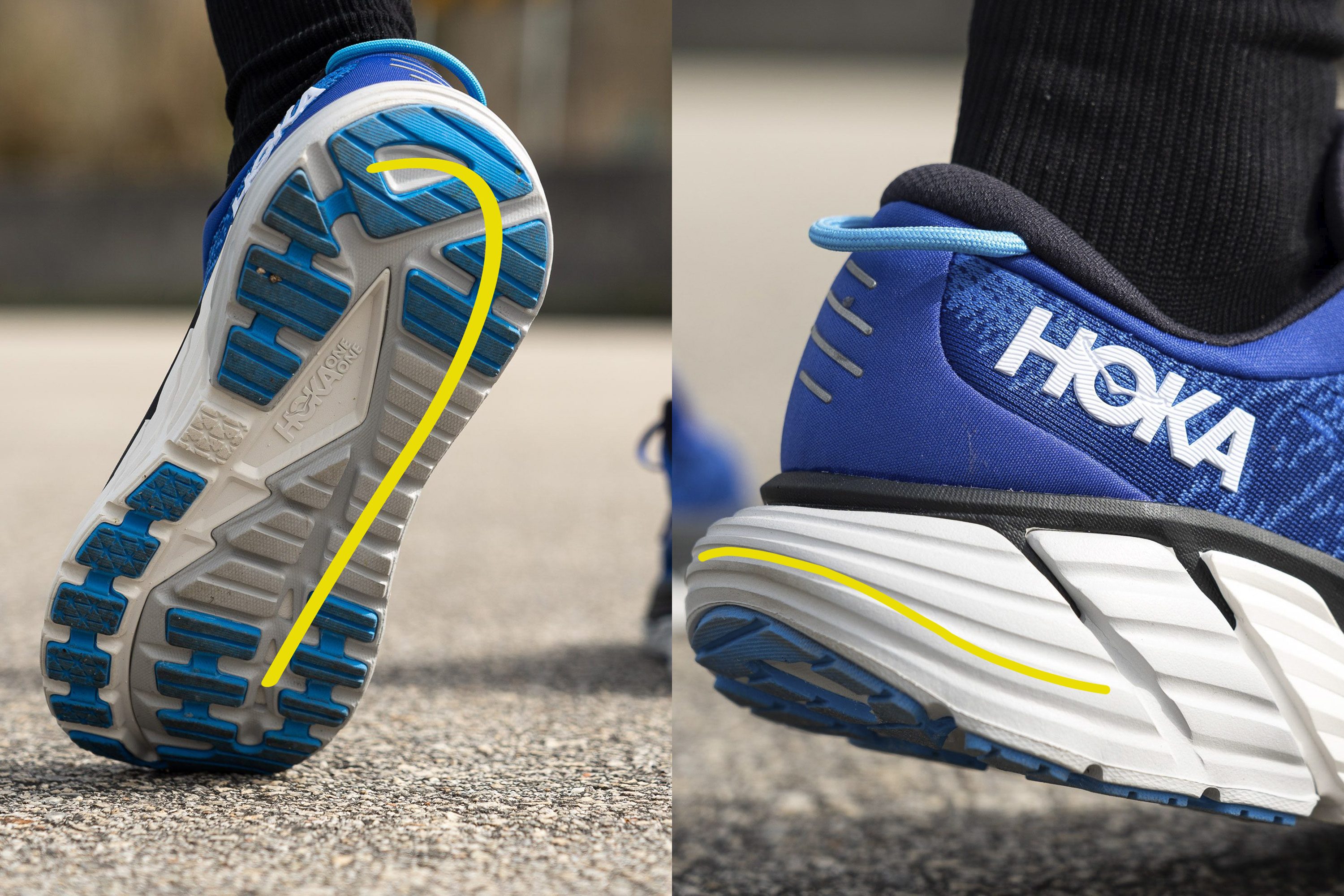
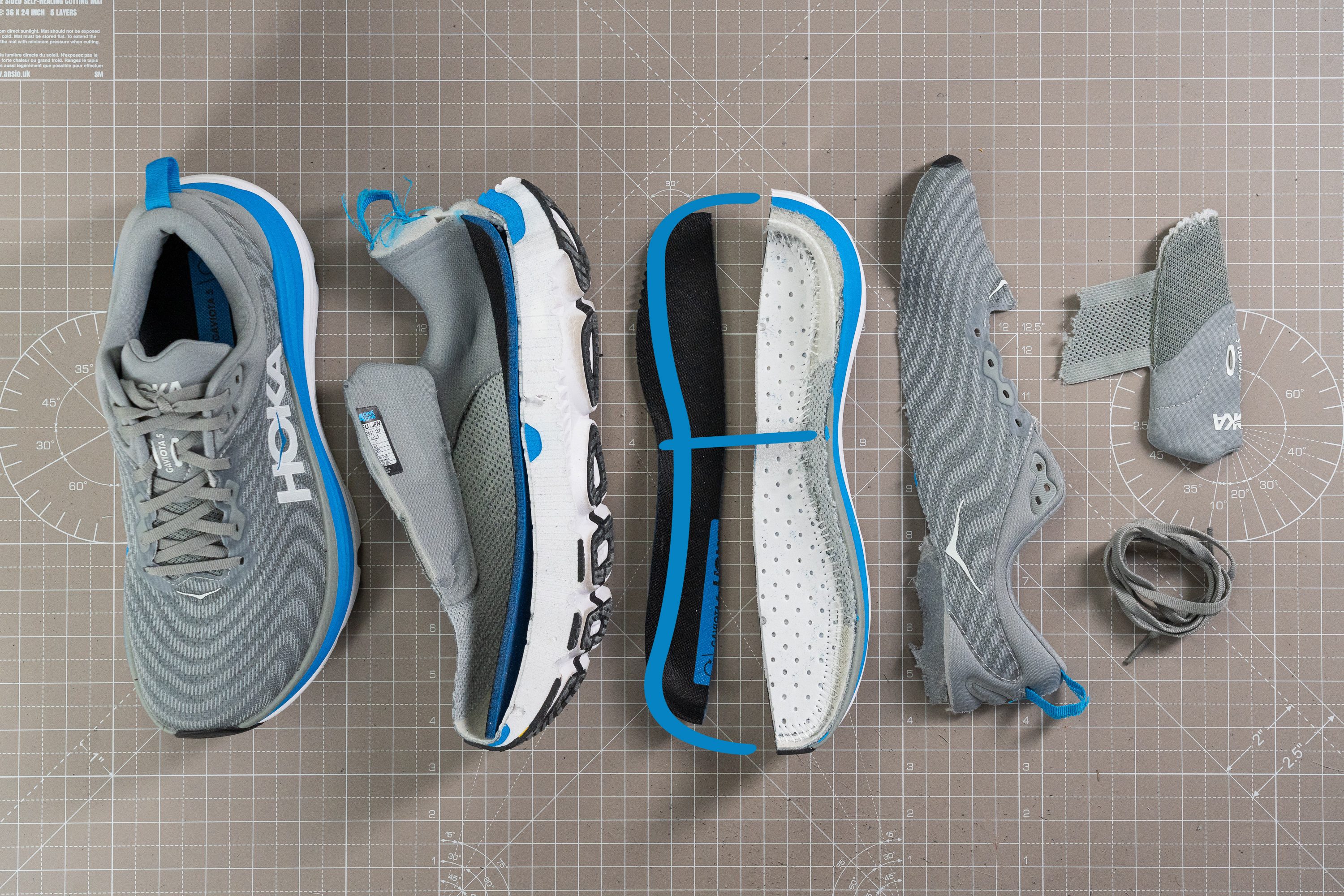
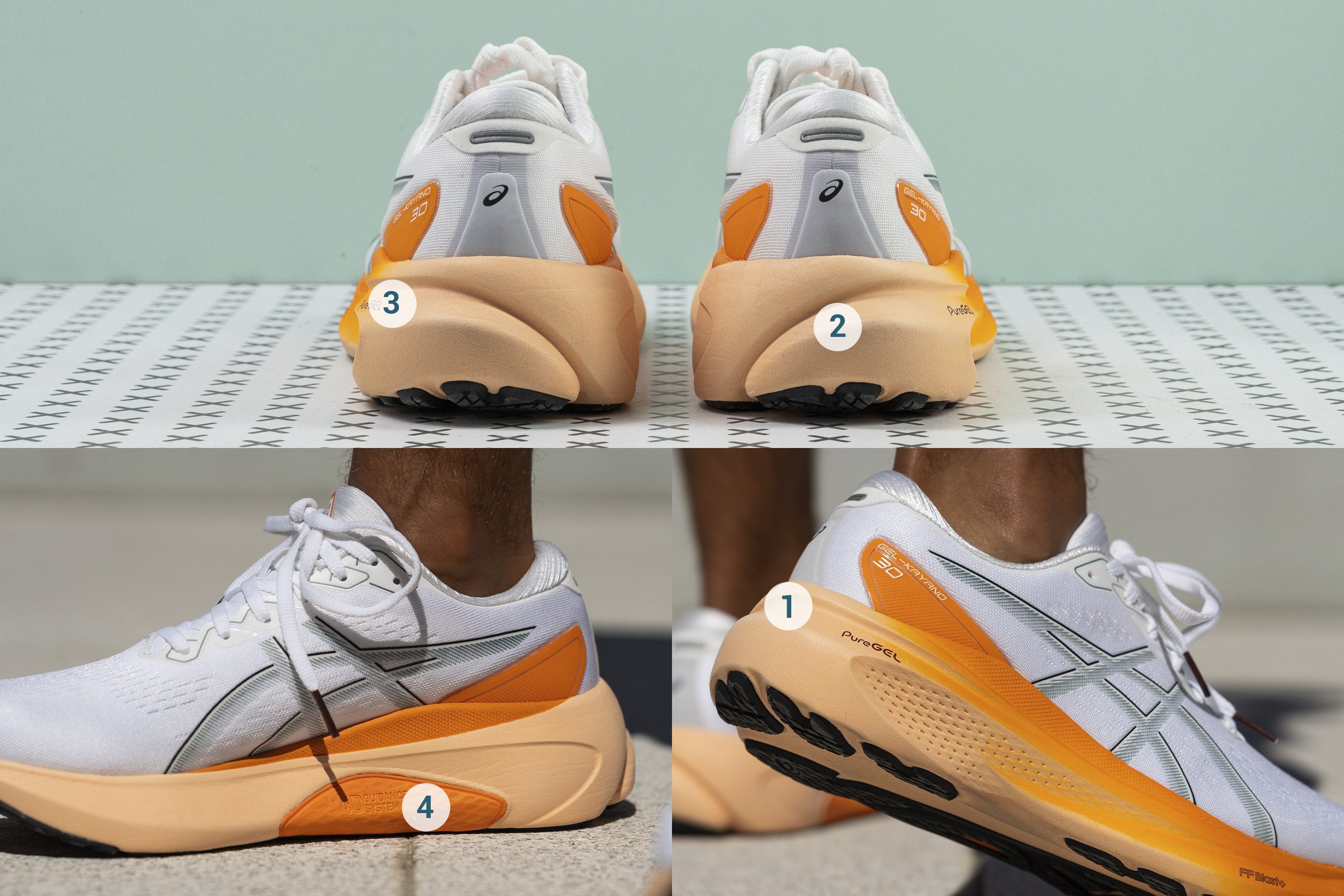
1) heel bevel 2) sculpted midsole 3) wider base 4) medial post
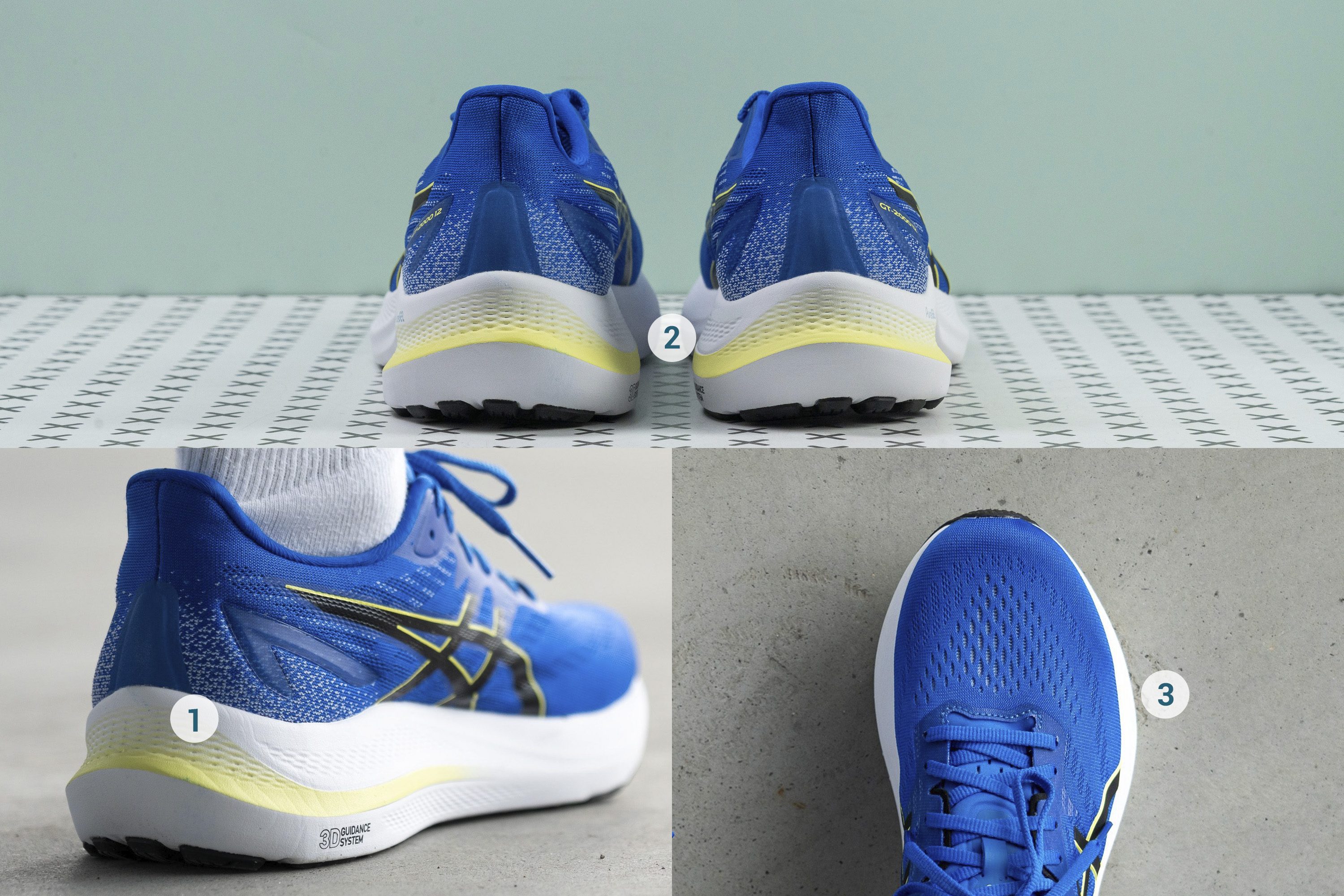
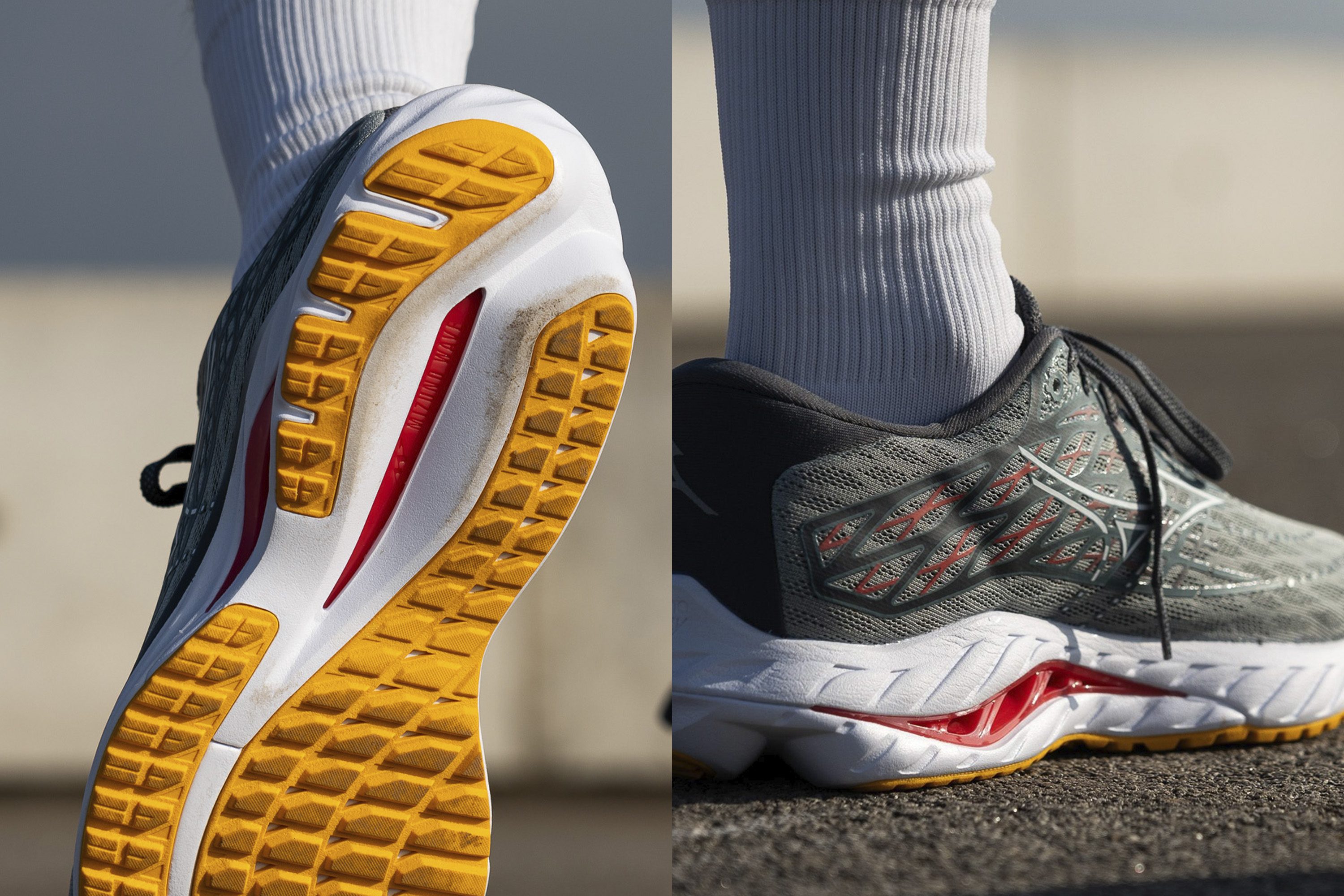
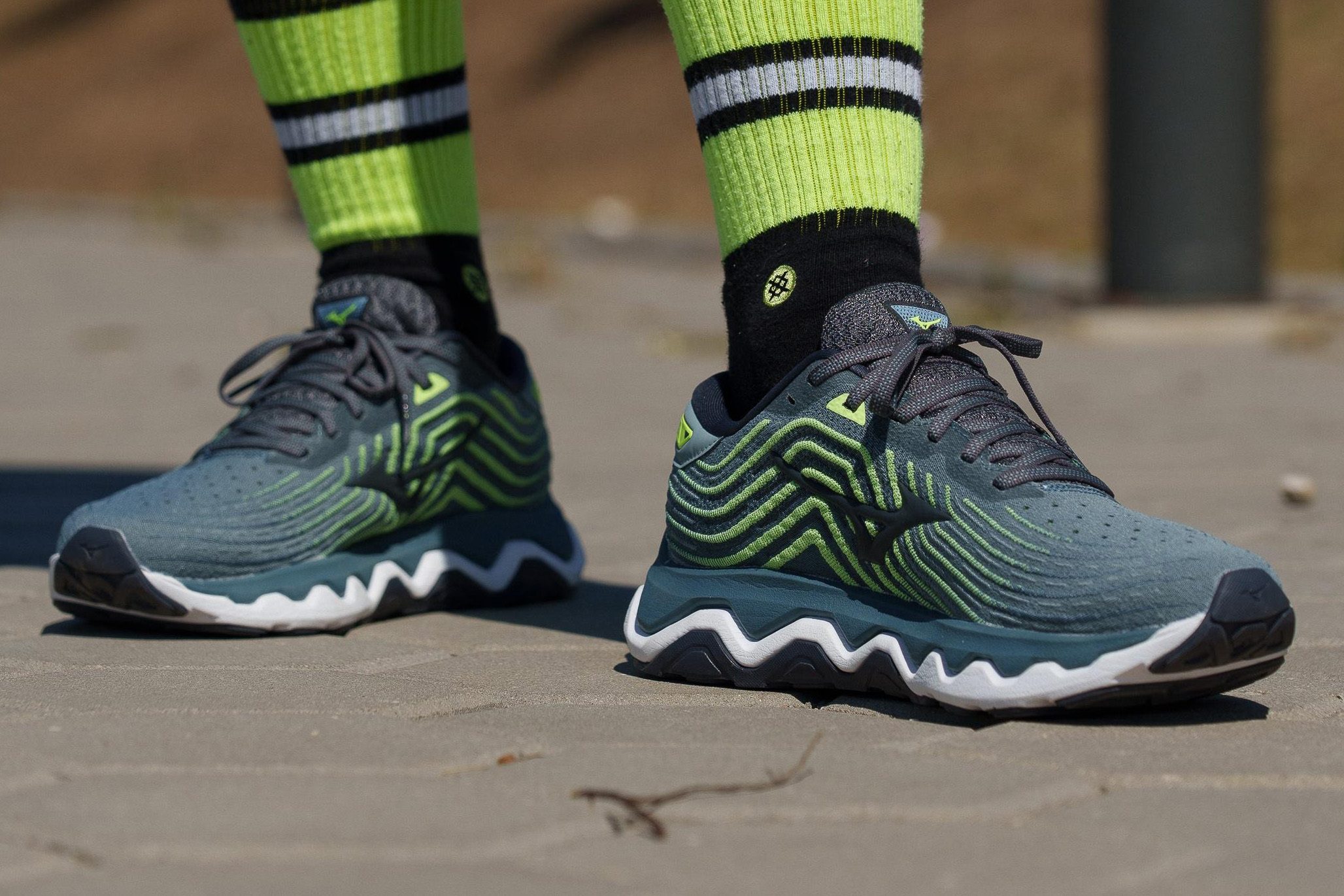
Shock absorption of stability running shoes
The softness of the midsole, even when it's dual-density, does not tell us how protective it is. It's the shock absorption that puts a number on that! It tells us how good the foam is at dampening the impact forces, and when it's very good, significantly less stress is sent to our legs.
Conversely, stability running shoes with very low shock absorption are unable to dampen the impact, which sends more stress to the feet and legs. This can cause foot fatigue or even pain.
For context, anything above 110 SA is considered moderate, and above 130 SA is high shock absorption.
Weight of the stability running shoes
Because of all the technologies implemented in stability running shoes, they tend to weigh more than neutral running shoes. Some, much more. See a few examples:
- Average weight of a neutral running shoe: 262.9g or 9.3 oz
- Average weight of a stability running shoe: 285.0g or 10.0 oz
- Lightest neutral shoe: 149g or 5.2 oz
- Lightest stability shoe: 228g or 8.0 oz
We always weigh every shoe that comes into our lab, and we don’t always get the same or even similar numbers as the brands advertised. We measure shoes in men’s US 9.
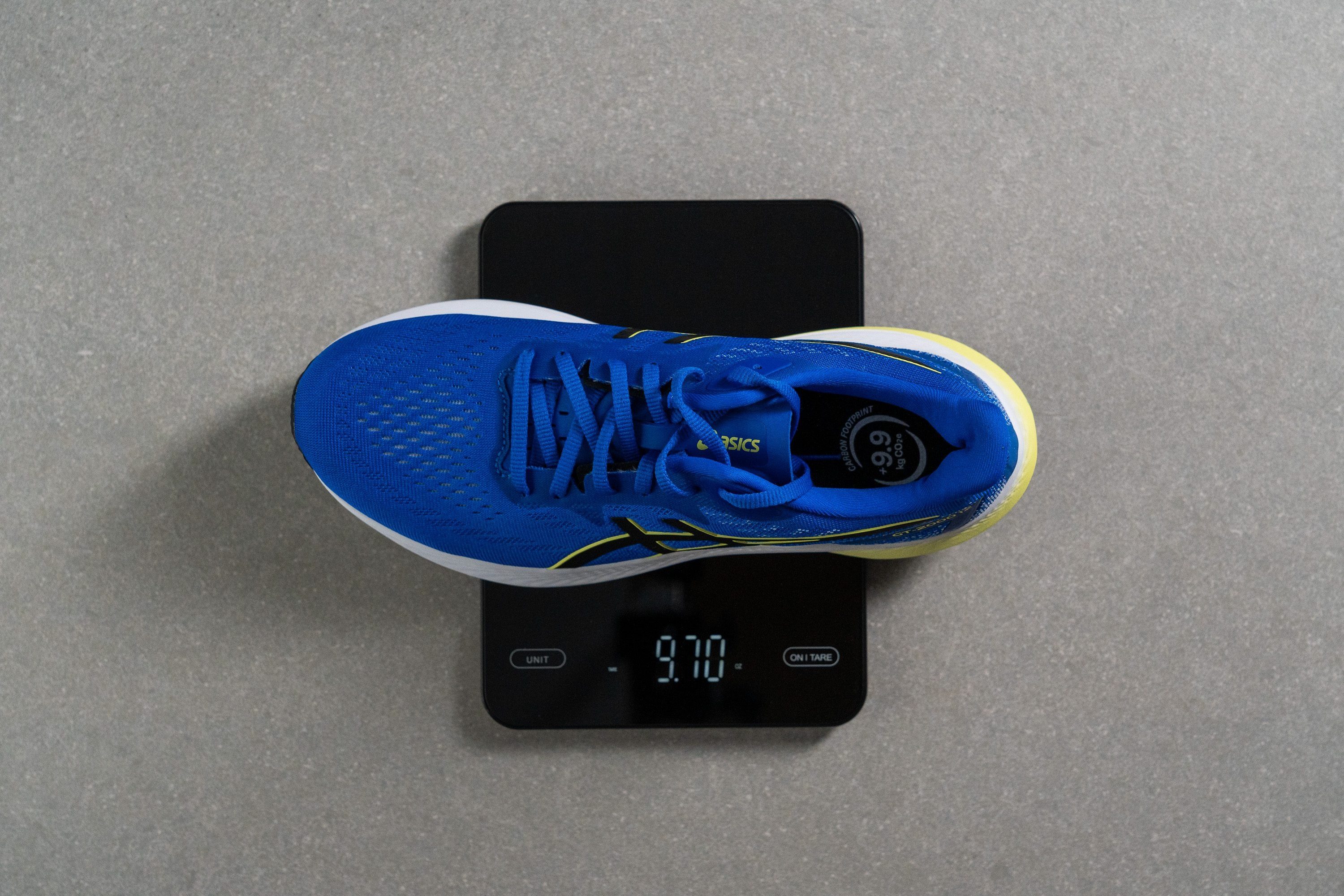
For context, here are the weights of the best-rated stability shoes:
And, if you want the lightest stability shoes possible, here’s the list:
How soft are stability running shoes?
Depends on the technologies and geometry. If more stability is given by a firmer midsole, then the midsole is firmer. If there are external stability elements, like a stiff heel counter, then the midsoles can be softer.
Regardless of the technology and geometry, we measure the softness of the midsole on every shoe. We cut it in half and stick the needle of the durometer in the foam. The number on the durometer tells us how soft or firm the midsole is: lower numbers mean softer, and higher numbers mean firmer.

In case we notice it’s a dual-density midsole, we take both measurements.
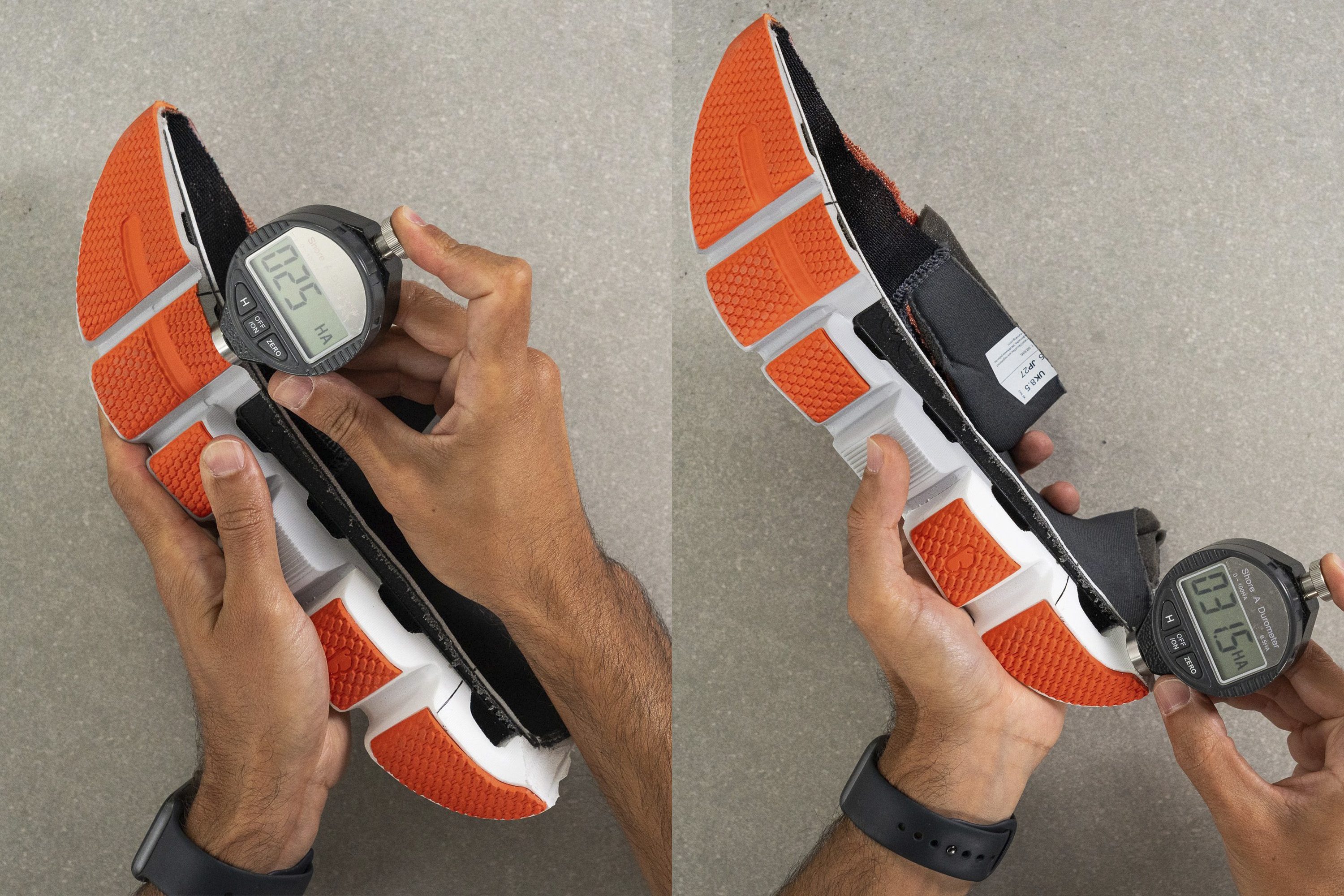
If you prefer softer running shoes, here are the softest ones we’ve tested (these tables are automatically updated with every review we do):
In case you prefer firmer midsoles, this selection is for you:
Durability of stability running shoes
When durability is discussed, most often, it’s the outsole durability that is mentioned. And, fair enough, it’s important to know how durable the outsole is, especially for overpronators who don’t land evenly on the heel and who see signs of wear and tear sooner because of it.
For the outsole durability test, we press our Dremel against the outsole (always the same pressure, RPMs, and duration) and then measure the depth of the damage using a tyre tread gauge.
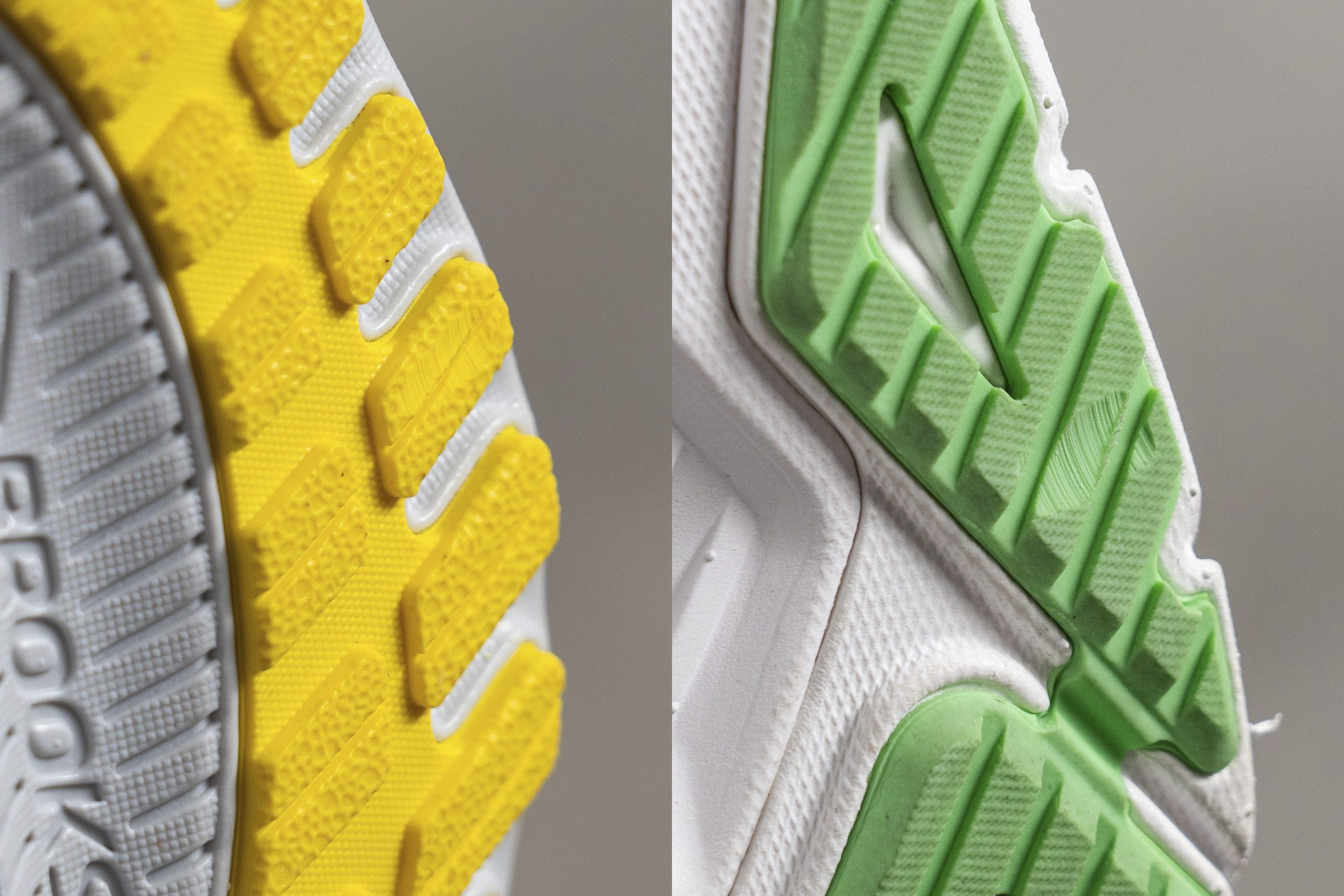
The deeper the dent, the less durable the outsole.
Of course, we don’t stop here. Using the Dremel again, we test the durability of the toebox and the heel padding.
But, in these 2 cases, we can’t measure the dent because the materials are soft. So, we assess the damage on a 1-5 scale, where 1 is the least durable.

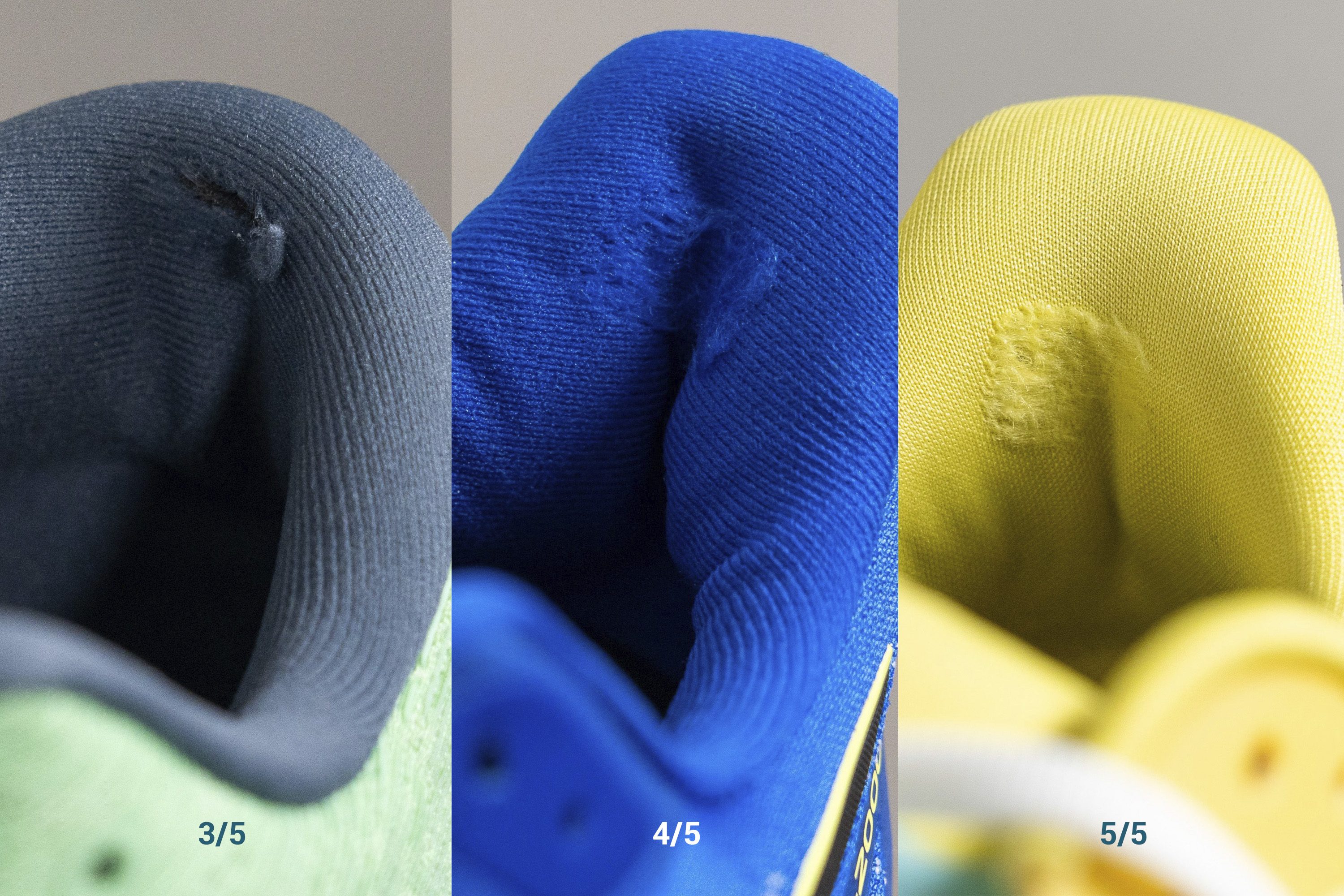
Stable running shoes vs. stability running shoes
Stability running shoes are not the same as stable neutral shoes. Neutral shoes can be stable on their own, but stability shoes have the technologies to help overpronators specifically.
Stable neutral shoes are still neutral, which means they have some geometrical stability elements, but would most likely not be enough for overpronators, except very mild ones.
|
Stability shoes |
Stable neutral shoes |
|
Both can have a wider base, heel flare, … |
|
|
Only stability shoes have GuideRails, GuideRail, J frame, H frame, etc. |
|
|
Both can work for mild pronation, depending on how mild. |
|
|
Best for moderate overpronation. |
Best for neutral pronation. |
|
Usually stiffer than neutral running shoes |
Usually more flexible and softer than stability shoes |

